
Base: All Respondents n=1809
Q13. What, if anything, have you heard about the telecommunications sector in the past year?
Unaided Awareness of Topics in the Telecommunications Sector - text version
POR Registration Number: 028-18
Contract Number: 3201706
ISSN: BC92-101/2018E-PDF
Cat. No. 978-0-660-28610-5
Contract value: $161,950
Contract Award Date: August 8th 2018
Delivery Date: September 27th 2018
Prepared for the Canadian Radio-television and Telecommunications Commission (CRTC). communications@crtc.gc.ca
Ce rapport est aussi disponible en français.
Unless otherwise specified, you may not reproduce materials in this publication, in whole or in part, for the purposes of commercial redistribution without prior written permission from the Canadian Radio-television and Telecommunications Commission’s (CRTC) copyright administrator. To obtain permission to reproduce Government of Canada materials for commercial purposes, apply for Crown Copyright Clearance by contacting:
The Canadian Radio-television and Telecommunications Commission (CRTC)
Ottawa, Ontario
Canada
K1A ON2
Tel: 819-997-0313
Toll-free: 1-877-249-2782 (in Canada only)
https://applications.crtc.gc.ca/contact/eng/library
© Her Majesty the Queen in Right of Canada, represented by the Canadian Radio-television and Telecommunications Commission, 2018. All rights reserved.
Download this report in PDF.
I hereby certify as Senior Officer of Ipsos that the deliverables fully comply with the Government of Canada political neutrality requirements outlined in the Communications Policy of the Government of Canada and Procedures for Planning and Contracting Public Opinion Research. Specifically, the deliverables do not include information on electoral voting intentions, political party preferences, standings with the electorate or ratings of the performance of a political party or its leaders.
Mike Colledge
President
Ipsos Public Affairs
The purpose of this POR was to examine claims of aggressive or misleading sales practices by telecommunications companies in Canada to provide evidence in support of a report requested by the Governor-in-Council.
The POR sought to better understand the prevalence of aggressive or misleading sales practices based on Canadians’ own perception of these tactics, how they define such practices and incidence of a specific set of sales tactics commonly heard through complaints to CCTS. The POR also sought to gauge Canadians’ level of concern with these sales practices in the contact of the broader telecommunications sector and their appetite for the government to take steps to address these concerns.
Overall, four in ten (40%) Canadians who responded to the online panel survey report having experienced sales practices by telecommunications companies in Canada that they consider to be aggressive or misleading, the majority of which report their most recent experience took place within the past year (60% of those who experienced these tactics or 24% of all Canadians).
Prevalence of aggressive or misleading sales practices is even higher when asked about a specific set of tactics with a majority of Canadians reporting salespeople pushing telecommunications products or services they are not interested in (55%), while four in ten have had technical support representatives attempt to sell them products or services during the support interaction (39%).
Generally speaking, Canadians express concern with a number of aspects of the telecommunications sector in Canada and a strong majority are extremely or very concerned specifically about misleading sales practices (58%), while nearly half are as concerned about aggressive sales practices (48%).
Among those impacted by aggressive or misleading sales practices, few have taken significant steps to address the issue beyond speaking to friends and family about their experience (48%) and while four in ten (39%) complained to their provider very few brought their concerns directly to the CCTS (8%).
There is strong sentiment among Canadians that they want action from government at all levels to tackle the issue (77% agree) and a strong majority look to the CRTC specifically to address their concerns (74% agree).
Ipsos was commissioned by the Canadian Radio-television and Telecommunications Commission (CRTC) to conduct public opinion research on Canada’s large telecommunications carriers’ sales practices.
On June 6, 2018, the CRTC was directed by the Governor-in-Council to make a report on the retail sales practices of Canada’s large telecommunications carriers and specifically to examine claims of aggressive or misleading sales practices, the prevalence and impact on consumers and potential solutions. The final report is due to be submitted by February 28, 2019.
At the heart of the request by the Governor-in-Council is an increase in concern expressed by Canadians on the issue of aggressive or misleading sales practices in the telecommunications sector.
The CRTC understands the concerns of Canadians. The commission launched a public consultation on July 16, 2018. In addition, the CRTC also undertook Public Opinion Research (POR) on the topic to measure the extent to which those practices are taking place and are perceived to be misleading or aggressive. This report addresses the POR component of the CRTC consultation.
Including POR as a component to the report to the Governor-in-Council allows the CRTC to measure the prevalence of these issues, Canadians opinions on the matter and to encourage participation in the consultation process. It is essential to the CRTC that a wide-variety of perspectives are included in any such research and on the public record. In particular, the CRTC sought to ensure that individuals who may not be able to participate in public proceedings are included in the research as well as those groups who may be more vulnerable due to age, a disability or a language barrier including Canadians with disabilities, seniors, third language communities and those who reside in smaller/remote communities. It is also essential that the opinions of both English and French language markets and those in Official Language Minority Communities are addressed in the POR.
The primary research objectives for this POR are as follows:
The POR undertaken by the CRTC was conducted in two primary phases including both qualitative and quantitative research as outlined in the table below. Appended to the report is detailed methodological information, as well as a copy of the quantitative survey questionnaire and qualitative discussion guide.
| Description | Details | Fieldwork Dates |
|---|---|---|
| Qualitative | ||
| Seniors | 2 focus groups in urban centres (Calgary & Halifax) 2 focus groups in small/rural communities (Val-D’Or & Sault Ste Marie) |
|
| Individuals with disabilities | 10 in-depth telephone/online-chat interviews |
|
| General public in rural communities | 1 online focus group in Whitehorse, Yukon 1 online focus group in Prince George, BC |
|
| Third language spoken at home | 1 online focus group in Toronto, ON 1 online focus group in Vancouver, BC |
|
| Official language minority community | 1 online focus group in Saint Boniface, MB and Moncton, NB 1 online focus group in Montreal, QC |
|
| Quantitative | ||
| Online panel survey | n=1603 completed surveys among a sample of Adult Canadians 18 year of age or older. The sample was stratified by age, gender and region to the representative proportions of adults Canadians Oversample of francophone market (n=206) |
|
| Public survey for voluntary participation | Hosted on CRTC website and promoted through CRTC social media channels. n=7075 completed surveys | |
| Paper-based survey | Available on request through the CRTC’s toll-free line. N=1 completed paper surveys | |
This section addresses awareness of prominent topics in the telecommunications sector as well as aided awareness of aggressive or misleading sales practices by telecommunications providers in Canada.
When asked on an unaided basis what they have heard about the telecommunications sector in the past year, if anything, the most common responses are related to the perception of expensive or high fees and the increase in rates over time.
Other prominent topics mentioned by Canadians include technological improvement, increased competition and the perception that Canadian customers pay higher rates than other developed nation.

Base: All Respondents n=1809
Q13. What, if anything, have you heard about the telecommunications sector in the past year?
Unaided Awareness of Topics in the Telecommunications Sector - text version
At more than four in ten (44%), a strong minority of Canadians indicate they are aware of the issue of aggressive or misleading sales practices in the telecommunications sectors in Canada.

Base: All Respondents n=1809
Q15. Before today, have you heard anything about aggressive or misleading sales practices in the telecommunications sector in Canada?
Aided Awareness of Aggressive or Misleading Sales Practices - text version
Most participants are aware of aggressive and/or misleading sales practices by Canadian telecom companies and some techniques elicit stronger dislike than others, whether or not they have experienced them personally.
“It has to do a lot with how the company does set up the structure for their marketing, versus service portion of that. The prime example is if you’re trying to go and buy a plan, your wait time is going to be considerably shorter versus say if you want to get a billing portion fixed or something that had to do with service side. They make you wait a long time before you have an opportunity to speak to them. I think it does go with the culture of how they started up for it to be.” – Third Language Vancouver
“Marketing is a different department, sales is a different department, customer service is a different department, they do communicate with their departments through different communication channels, but to us, as a customer, we just take them as one whole company, right?” - Rural Community BC
“People showing up at night to sell me a new product, this is Telus. Somebody else showing up at my house telling me that they want to rewire my house for a new product, and I say: ‘Well, I don’t want the new product’. They say: ‘Well, if we don’t do this now and you change your mind, it’s going to cost you $1,000 a month’, right? So I said: ‘Fine, I don’t want it, I don’t care about the $1,000’. So twice they came to my place and we had the same discussion. And I’m mowing my lawn one day and holy cow there’s all these wires that are screwed into my wall, that I’d never seen before. Fiberoptic. They must’ve come in and did it anyway, and they would have had to climb the fence because it’s locked. I mean what are you going to do? I felt like actually cutting the wires off and tossing them in the garbage but, you know, they went onto my property without permission.” – Senior, Calgary
This section addresses the level of concern Canadians attribute to different aspects of the telecommunications sector in Canada, the proportion of Canadians who feel they have personally experienced aggressive or misleading sales practices and the timeframe in which those experiences took place.
A strong majority of Canadians express concern with a number of aspects of the telecommunications sector in Canada. Level of concern is highest for:

Base: All Respondents n=1809
Q14. How concerned are you about each of the following in the telecommunications sector in Canada?
Nearly half of Canadians also express concern with aggressive sales practices (48%), while closer to four in ten are concerned about the amount of competition in the telecommunications sector in Canada (41%), length of contract periods (40%) and to a lesser extent access to services in rural areas (34%).

Base: All Respondents n=1809
Q14. How concerned are you about each of the following in the telecommunications sector in Canada?
Four in ten (40%) Canadians indicate they have personally experienced sales practices they would consider aggressive or misleading from telecommunications providers in Canada.
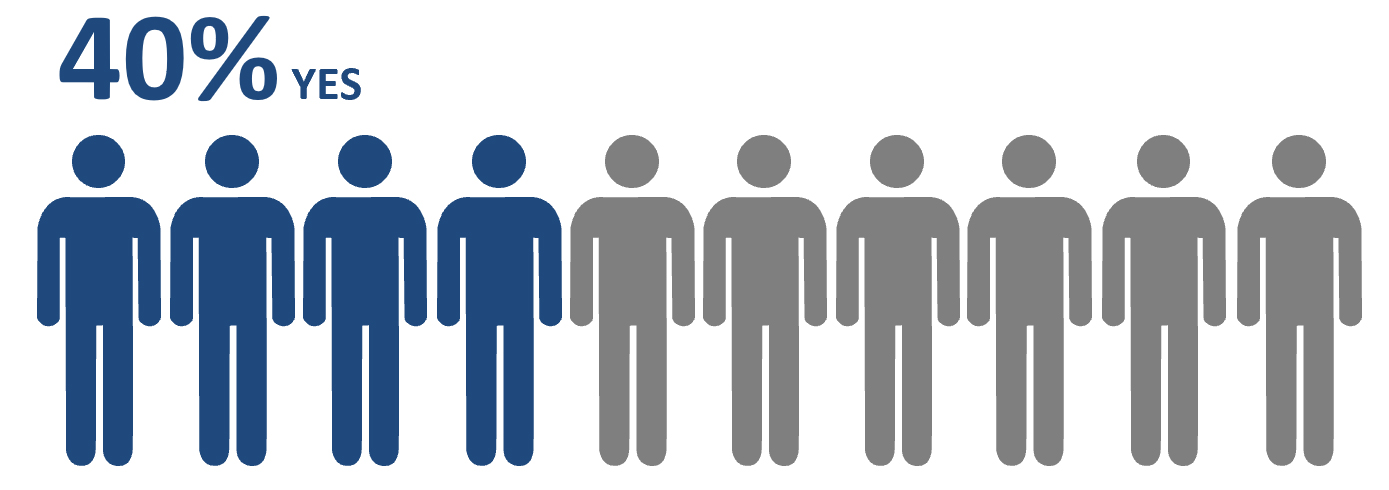
Base: All Respondents n=1809
Q16. Have you ever experienced any sales practices you would consider aggressive or misleading from telecommunications providers in Canada?
Personally experienced aggressive or misleading sales practices - text version
Of the four in ten who have personally experienced sales practices they consider aggressive or misleading, the vast majority indicate it was in the past year (60%), of which three in ten indicate it was either in the past 6 months (29%) or in the past 6 to 12 months (31%). One-third say their experience was more than a year ago but within the past five year (34%) and fewer than one in ten more than five years ago (7%)
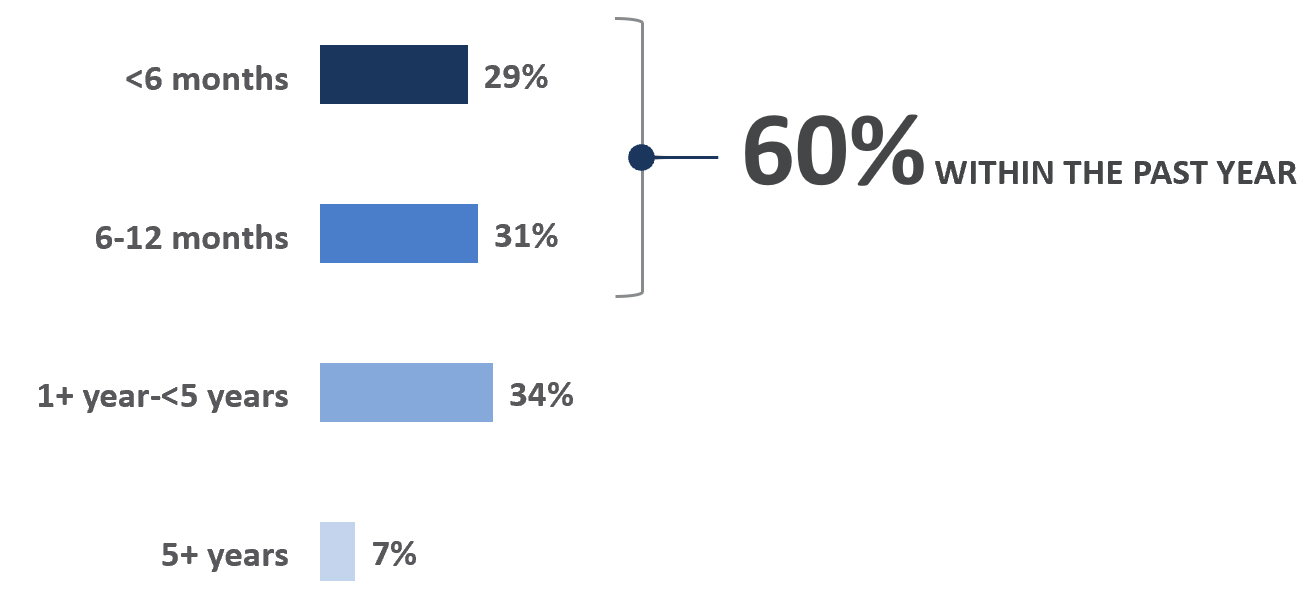
Base: Experienced aggressive or misleading sales practices (n=711)
Q17. When did you last experience this situation?
Many participants believe that telecom companies engage in pricing practices that are unfair to them as consumers.
There were numerous pricing practices that we heard about in the qualitative research which were of concern to participants:
Participants would like a choice in how they interact with their telecom, rather than having it forced upon them.
“I don’t mind getting TV and digital ads or targeted flyers, just because it does let me know what is available to me should I be shopping around for a different service. I don’t however appreciate mobile device ads or email ads, or phone calls, just because it’s my choice to pick up that flyer, not being pushed into my face like a phone call or door to door salesperson would be.” – Northwest Territories & Yukon
“I get fairly aggressive after a while and I just turn it on them, ‘do you not understand the word no means no, you know, I have a life, get out!” – Senior, Calgary
“But it's the salesperson on the door, and I don't want to be rude so that's a tough spot for me sometimes. I end up listening to them even though I don't want to just because I feel like the person is doing his job so I don't want to be rude.” – Rural Community BC
“I find that sometimes you know, the price will go up and things will change and you’re not really notified of that. You’re led to believe that you are going to have the same price where you know, they change it on you and you don’t really know and the wait times are pretty long on the phone [for an explanation]. “– Person with Disability, BC
“So, every month I get on the phone and I say ‘hey, my bill is $5 more a month, why? “– Senior, Calgary
“My bill, the one that I’m referring to was $180, it was $138 exactly a year ago. So, from $138 to $180 was 30%, that’s in one year! My service hasn’t been changed in any way. Nobody said they’re doing this because it’s good for me or I’m going to get all this extra service.” – Senior, Calgary
“I called and was changing a few years ago my settings and different programs, and they said yes, you’ll get this and this. Then I get the bill and it’s totally different from what we discussed on the phone. And of course it was much higher than what we discussed on the phone. And so I called them, and it took about two hours to finally resolve. They would send me to another department, and another department, and it was quite annoying. And then they sent me the new bill, still there was something wrong. And so I don’t know who the people in accounting, or whoever they were, but it took quite a while to resolve it.” – Senior, Halifax
“[…] these companies should give long-term clients loyalty discounts to show they are appreciated, instead of having to threaten to cancel the service because they're dissatisfied with the service.” – Minority Language, Saint Boniface/Moncton
“These incentives all seem to be for new customers to that company, and I know some of you have talked about switching and so on. But my wife said there was one here, it said $500 pre-paid card if you bundle TV and internet. I don’t know what company that was but that’s only for new customers. We’ve been with Telus for over 50 years and we get zip, you know, we only get increases from month to month. Our TV went from $79 to $84 from May to August and our internet from $61 to $71 for exactly the same service, and they keep doing that.” – Senior, Calgary
“All they had to do was send me the free phone and everything would have been hunky dory but they refused to. They said that I wasn’t owed one, and I said them well who goes on a 2-year contract without getting a free phone? […] I get a collection agency calling me and I keep telling them the same thing. Tell them to send me the free phone and I’ll pay the outstanding balance […] Every time they keep telling me the same thing, I’m sorry sir, I’m just a collection agency to collect your funds. That’s not part of my job […] In the beginning, I talked to six different people about the same thing and each time they said well I’m sorry, I can’t do anything about it. So I frustrated to the point where now I just block their calls because I’m not getting anywhere, I’m not getting through to them that they still owe me a free phone.” – Person with Disability, Alberta
“I had a contract with Bell and I wanted to drop them and go back to Shaw. They told me that it was going to cost me $600. I basically said, you folks can come and get it because I'm not paying it and my argument is that your service is crappy and that's why I'm quitting. That was the last I ever heard from them.” – Senior, Sault Ste Marie
“Yeah, well I really think it’s unfair that somebody with the same Bell plan can pay more or less depending on just what they’re willing to pay. You know, Rogers and Bell they go back and forth on their pricing and I feel like that’s really unfair. Some people would just be happy with it, ‘oh that’s the price, okay I’ll pay that’, but really they don’t know if they, you know, tried to get a discount that they might actually get a discount. So yeah, I just find it really unfair and I don’t like that kind of pricing game. And they sort of have a monopoly on the market, people don’t really know that there’s other companies out there that are really competitive and offer good services.”- Third Language, Toronto
“I'm with Shaw too and I don't agree with the billing way ahead. Like, I've got the October 15th bill and September 15th even isn't here yet. They do that all the time. I have my internet and cable with them. I am always having problems with cable.” – Senior, Calgary
“I had this phone plan that I had since high school. It was a really good phone plan, it had a really incredible amount of data that was offered at the time when data was cheap to offer. And the thing was I had to buy my own device every time if I needed a new one, so I couldn’t get it through the plan. And I guess they weren’t too happy offering me this plan, so they kept offering me what they would call upgrades, but they would also include a more expensive plan just to try to get me on the new program. And I repeatedly told them no, I’m totally happy buying this device myself. I don’t want to be paying $80 a month for my phone bill.” – Third Language, Vancouver
“I have to say a lot of us up in the North have been gouged for a long time. We haven’t had lots of options, and with some of the other companies started to come in that’s when the prices started to drop. The only other thing I wanted to add is, I know a whole bunch of people that have cancelled all of their telephone landlines because of cellphones, their TV internet services because they have Crave internet, Amazon TV, all of that stuff. So we have a lot of decisions to make when we’re moving forward with how we want to spend our money.” – Northwest Territories & Yukon
A few express dismay that telecom companies engage in what they perceive as an excessive amount of sales and marketing, in that they feel they are already spending a sizeable amount of money each month on their services, and the perception is that they are constantly being sold on more.
Experiences within each telecom can vary – not just across different telecommunications providers.
The inconsistencies between individual representatives such as varying awareness of different plans, or a lack of record-keeping about calls between other representatives, often means that participants will employ various tactics and negotiation strategies in dealing with their telecommunications provider – these include asking to speak to a manager or retention department, adopting a more forceful tone, or obtaining an offer from a competitor – in order to get the best pricing and packages. While a few take pride in their ability to navigate the system, most express frustration and concern that they should have to resort to these actions.
“I just find that sometimes, you know, one rep will tell you one thing and then another rep, if you call back, will tell you another thing, so it’s very frustrating. That to me is the most frustrating, is when they don’t really know their packages themselves or, you know, they try and… you feel like you’re being tricked. You don’t know whether it’s because they’re not fully aware or if they’re, you know, trying to trick you.” – Third Language, Montreal
This section addresses how Canadians would describe their own experiences with aggressive or misleading sales practices, the proportion of Canadians who have experienced specific activities considered to be aggressive or misleading sales practices on the part of telecommunications providers and the actions they have taken following their experience.
Among the four in ten who have personally experienced sales practices they consider aggressive or misleading, nearly one-third described their experience as aggressive sales practices (32%) followed closely by those who described their experience as misleading sales practices (30%). Other common issues mentioned specifically include door-to-door pressure tactics (7%), billing issues (7%) or poor customer service (5%).

Base: Experienced aggressive or misleading sales practices (n=711)
Q18. What did you experience? Please be as specific as possible.
Description of experiences with aggressive or misleading sales practices - text version
Below are verbatim comments from the most prominent categories of open-ended responses.
- ‘A door to door person trying to aggressively make me switch over. Wouldn't take no for an answer and would not leave.’
- ‘Aggressive selling by telemarketers or customer service people. Really, you don't understand what NO means?!’
- ‘A salesman arrived at my door with an offer that sounded too good to be true. I asked for his name and employee number to verify the offer, but he refused and became belligerent.’
- ‘Aggressive sales persons coming to my home trying to get me to switch providers, or purchase services I don't need or want.’
- ‘When I was enquiringly about the cost of bundling services and possibly switching over to Telus a few years ago I was harassed by a sales person and his supervisor from and out of country call centre. They called me back several times after I stated I was no longer interested in switching over. I ended up having to block the number in order to stop the calls.’
- ‘Aggressive sales pitch, refused to cease behaviour, forced to slam door in their face.’
- ‘We get NUMEROUS phone calls from both Rogers & Bell claiming they can offer us lower rates for better service. Rogers is terrible at insisting they can offer more options for less than we already pay and will call repeatedly. BELL -- who we are with constantly tries to get us to add services we don't need.’
- ‘A Bell sales rep told me that if it took a certain package it will last for 2 years, but once the first year ended the prices went up.’
- ‘A company told me about how awesome the service (coverage) they provided was in my area was. I know from several people there is almost zero or spotty coverage.’
- ‘A rep tried to sell me a bundle for a reasonable price but when it came to actually sign the papers, the price was twice as much.’
- ‘A sales rep telling us we won a free year of their product. Phone Sask Tel and told them about this and they said they had no one offering this free stuff.’
- ‘Aggressive sales people at malls, talking up one price, then when it's time to sign the paperwork they've inflated the price because they fail to mention all the add on costs.’
- ‘Being told if I sign with a phone and plan contract for 2 years, I would receive a $200 gift card. In the end, all I received was a credit against my phone bill for $200.’
- ‘Bell Canada promised me A certain price for my bundle very explicitly online during a chat. Once it was all installed, they reneged.my cost went up by 25 percent. They just said she shouldn't have quoted me that price online. Too bad for me.’
- ‘When I signed up for my internet they made the plan sound much better than it was. They didn't really mention that it would go up in price halfway through the contract.’
- ‘We switched from Rogers to Bell for TV and internet. We were offered huge discounts to switch and were told to call Bell when the promotion ended to renew discounts. Guess what? No such luck. My costs went up from 242 per month to 353 per month.’
- ‘We signed a contract with Telus after a home visit by a salesperson, then cancelled the contract two days later when we found out (after calling Telus directly) that we had been given some false information.’
- ‘Was told that the rate would be for the entire contract, but two months later the rate was increased’
When asked whether they have experienced specific sales practices, just over half of Canadians (55%) report having interacted with a salespeople pushing telecommunications products or services they are not interested in, while a sizeable minority (39%) indicate having technical support representatives trying to sell them products or services during the support call or interaction.
Approximately three in ten Canadians experienced rebate/discount offers where terms differ from the original information provided by the provider (32%), salespeople providing details of telecommunications products or services which end up being false (31%) or rebate/discount offers where terms are not disclosed before purchase (28%).
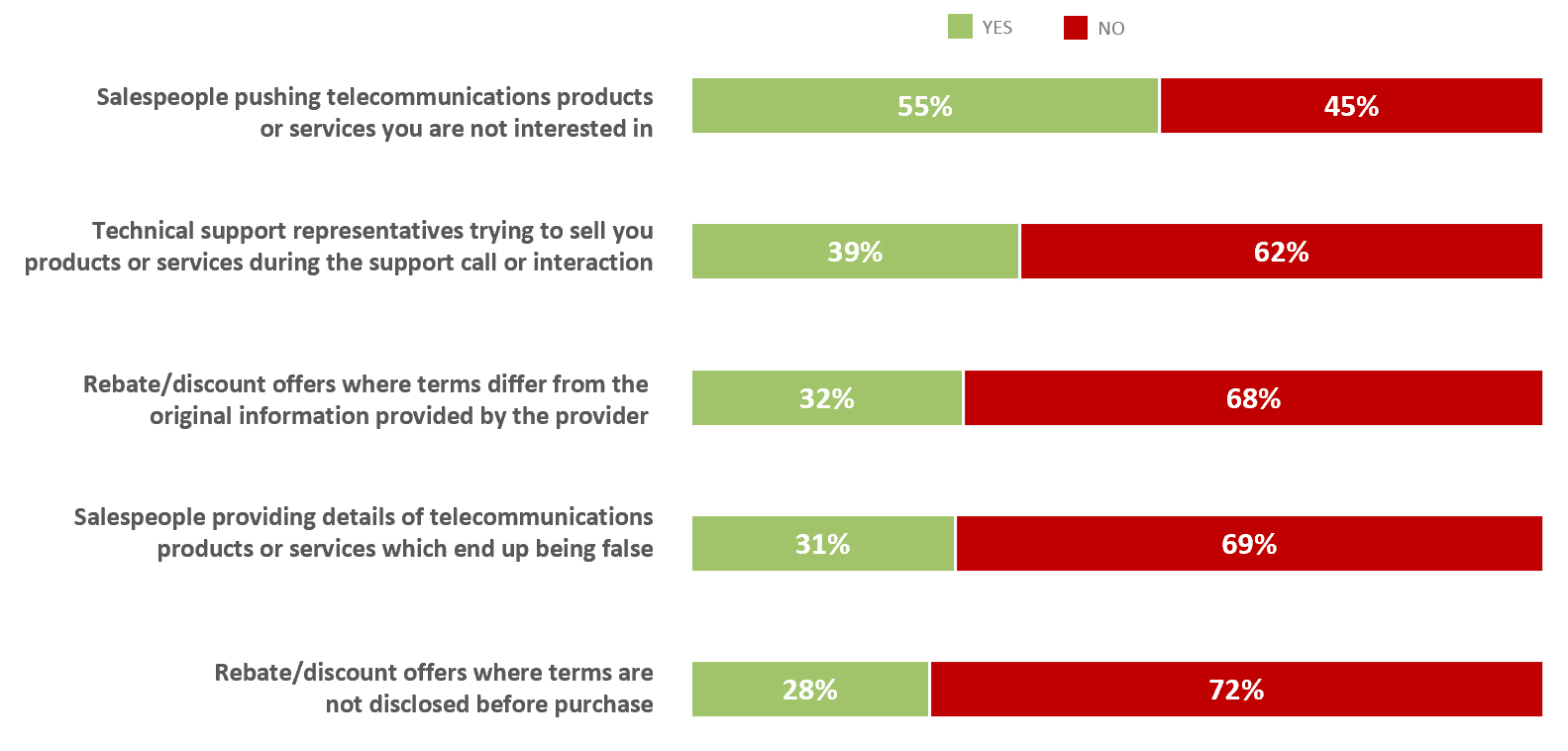
Base: All Respondents (n=1809)
Q21. Have you ever personally experienced any of these situations?
Experiences with specific aggressive or misleading sales practices - text version
The most common steps taken after experiencing an interaction they would classify as aggressive or misleading sales practices are to:
Nearly one in ten (8%) complained to CCTS directly while close to two in ten took no action (18%).

Base: Experienced aggressive or misleading sales practices (n=711)
Q19. What, if anything, did you do about it?
Actions taken after experience with aggressive or misleading sales practices - text version
When profiled by demographic information a number of notable differences exist between those who have experienced aggressive or misleading sales practices versus those who have not.
Canadians who have experienced aggressive or misleading sales practices are statistically more likely than those who have not experienced these sales tactics to be:
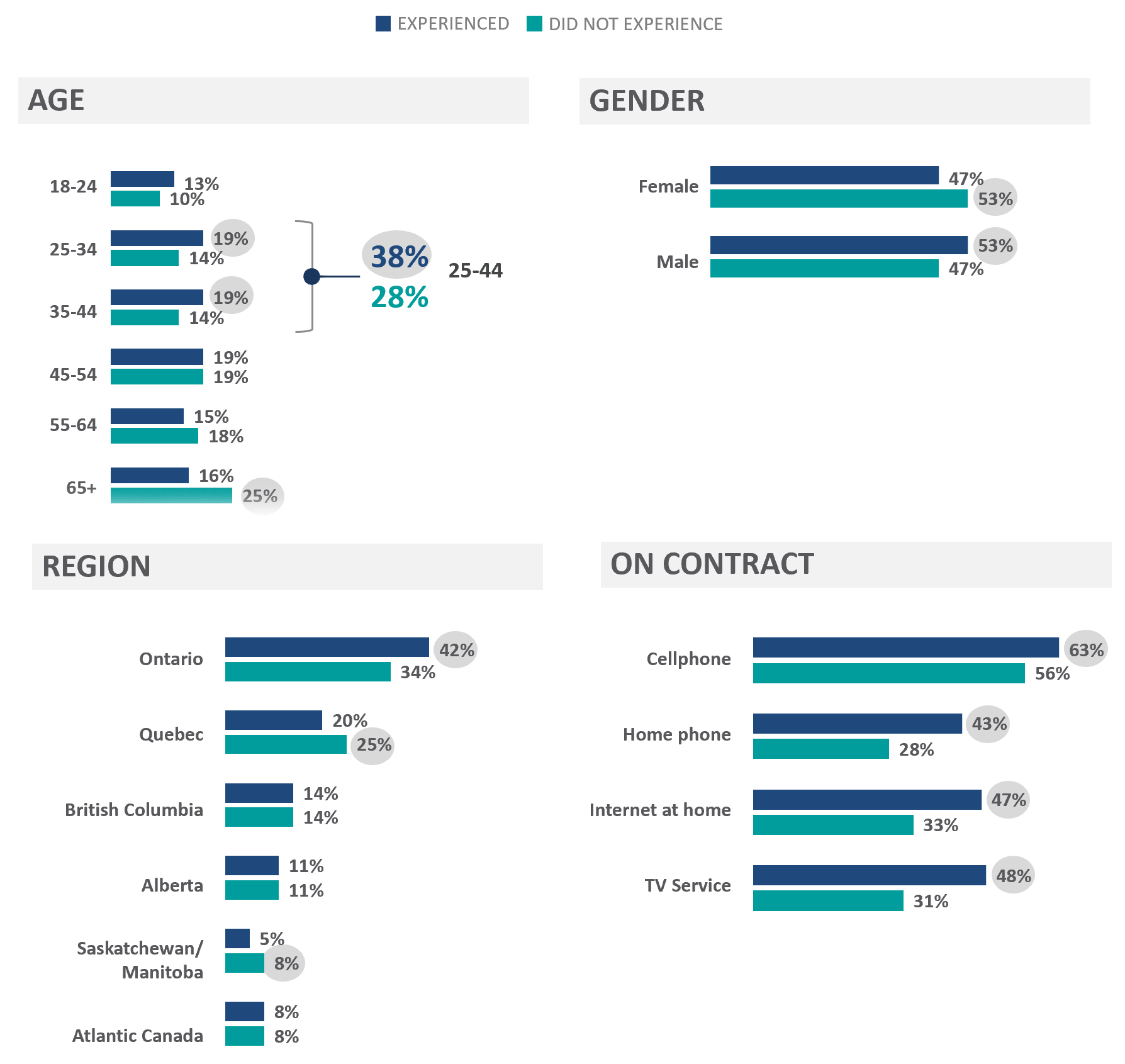
Base: Experienced aggressive or misleading sales practices (n=711), Did not experience aggressive or misleading sales practices (n=1098)
Profile by age, gender, region and on contract - text version
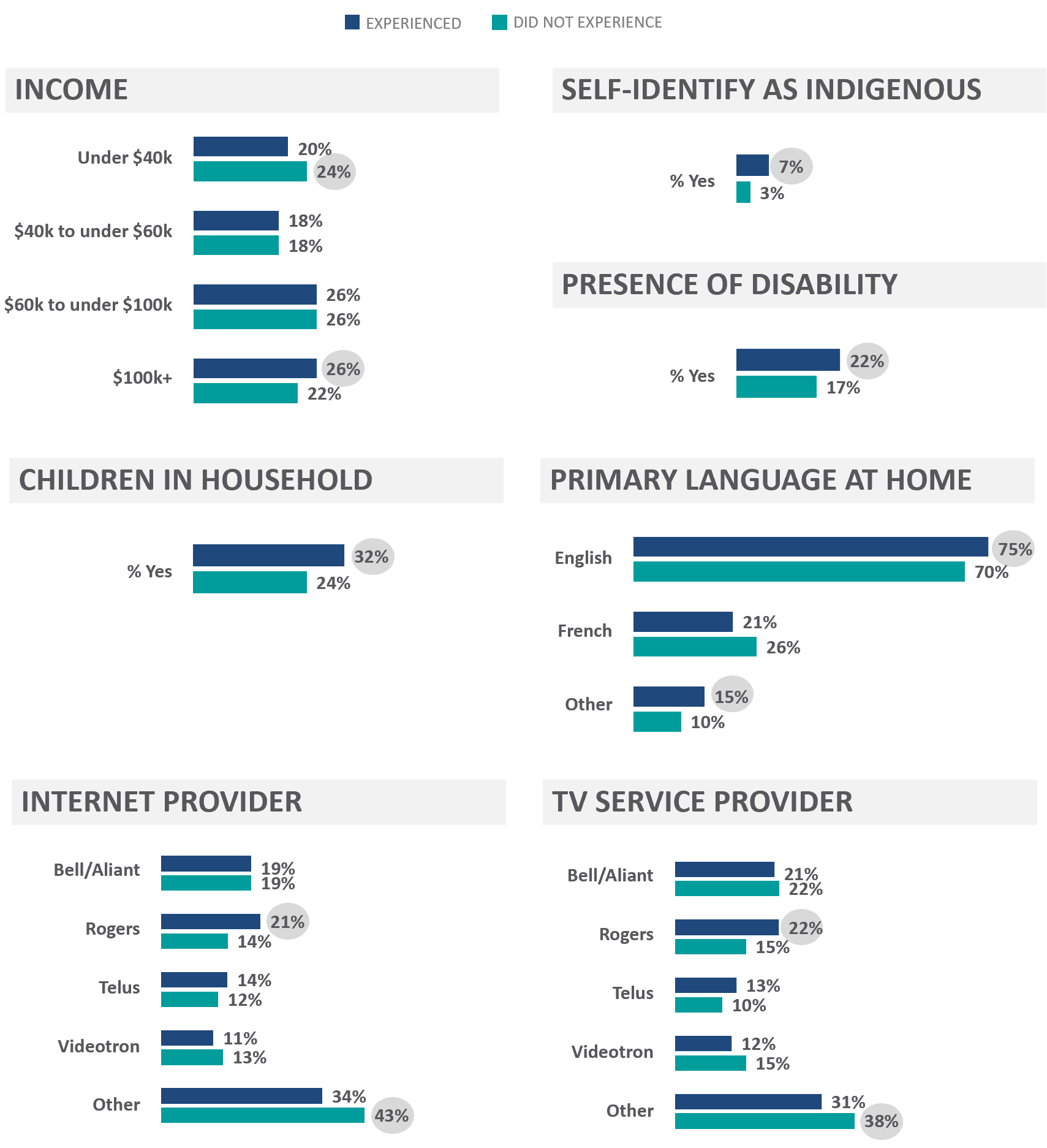
Base: Experienced aggressive or misleading sales practices (n=711), Did not experience aggressive or misleading sales practices (n=1098)
Many participants had experiences with aggressive or misleading sales and marketing practices and these were very poorly perceived. Other practices received more of a mixed reaction. Broadly, any sales and marketing practice where the customer feels they don’t have a choice in engaging in the interaction is the most frustrating, and the ones where they are able to view the information on their own time and terms were the most favourably viewed.
“Well, the digital ads and television ads, they are there. yes, they made me advertising that they will appeal to you as a customer, but it's our decision whether we like it or we don't. We also have the power to change the channel that we don't watch to watch it, right? But it's the salesperson on the door, and I don't want to be rude so that's a tough spot for me sometimes. I end up listening to them even though I don't want to just because I feel like the person is doing his job so I don't want to be rude.” – Rural Community BC
“Two young Asian girls, very attractive, maybe late teens, maybe 20, at like about 9 o’clock in the morning. Like this just shocked me, okay. I don’t know, it was about a week or so ago and she wanted me to take Telus, and I said I’ve already got Shaw’. And she said ‘oh but we’ll give you a very good deal’ and I said ‘well I’ve just signed a 2-year contract’ and I said I got a great price, and she said ‘what’s your great price?’. I said ‘$101, internet, phone and television, cable’. And she said ‘oh we can beat that, we can give you that for $81, we can even get you out of your contract’. Can you imagine?, ‘we can get you out of that contract, it won’t cost you anything, you can sign with us for $81’. I said ‘well I couldn’t handle another hassle like this’, you know.” – Senior, Calgary
“I just talked to my friends and they said that it was annoying and that I wasn’t the only one that was getting harassed by a company, and yeah, they are good with that […]I think the difference is they insist a lot even though you are saying that you are not interested. They will keep speaking and speaking and leaving you voicemails and that’s almost harassment. It’s just too much. You feel like they are too close to you and it’s not fun [… ]Yeah, you tell them okay, I’m sorry I’m not interested, but oh yeah, this will just take a minute and there’s this super deal and they keep speaking and you almost have to hang up on them so they can shut up […] It’s really frustrating. It’s not fun. You have a life to live and when they are always calling you, it’s not fun.” -Person with Disability, Quebec
“Most of the time they try to pressure you. You only have until tomorrow morning to decide that if you want to do this and you know, price is going to go up. Well, we had the last call from Shaw [at midnight]. My husband was talking to them and they said this is going to only be available until tomorrow morning, so you have to tell me tonight. It sounded like a really good idea, but they said we need to know now and I said to my husband, it's too good to be true. My husband said we need time to think about it. Well, you know, they can't do better so...” – Senior, Sault Ste. Maire
“[…] then there was this Bell guy who came up and he just like wanted to talk and tell us about the services. So I was just being nice and opened the door and was trying to listen to what he had, so he took like I would say more than an hour to explain his services. But yeah, okay I was being nice to him but then what happened the next day, he came again. I told him if I’m going to get the service, I’m going to call you and I’m going to let you know. But this guy, he kept coming for more than a week, he used to wait in his car for like long hours right in front of our home. And that I think is annoying and concerning for me, because I wasn’t feeling comfortable going out of my house, right. So I think that was pretty annoying to me.” – Third Language, Toronto
“[…]they should offer you the best service across the boards either Bell or Rogers should be all the same thing, it shouldn’t be all this price gouging or make me special deals when you complain. You shouldn’t have to go that far.“ – Person with Disability, Ontario
“Yes, we’ve had messages from our provider. We’re just learning how to get into them and we’ve had help from family and friends so we are getting better at it. It is a good way to see their specials and things, yes.” – Person with Disability, ON
“I don't mind getting text messages from people that I know but I hate getting these text messages, I just find them so annoying. They are usually being intrusive when I'm in the middle of something and interrupting my train of thought because of this stupid text message.” – Rural Community BC
“Especially targeted flyers, there are some I feel they’re very misleading certain times where I don’t know if that’s a past practice or not, but I had an experience where the flyer comes out, you look and it’s a great deal, you go there, and oh boy there’s tiny print where you have to sign this many years, buy this particular phone at this particular price. Starting at $29.95 you can get this, but no, if you want the better phone you have to be on the $100 plan. You can’t get it for $29 anymore. So that’s what I’ve seen before.” – Third Language, BC
“Whether it's on the TV or the computer, it's not unpleasant. And you can still skip them if you want.” – Minority Language Saint Boniface/Moncton
“For me I find all your TV ads are geared to down south, in our case Vancouver or Edmonton area, and they don’t apply up here. Of course they’re selling high speed unlimited internet, well we don’t have those options. And even most of the cell providers that are advertising all these wonderful plans, we can’t get them anyway, we don’t have those providers. So really, in my experience the TV ads are just if you want to watch it for interest, go ahead. If you want to drool a little bit over what they’re offering, okay. But they’re meaningless anyway.” – Northwest Territories/Yukon
“I've had many negative experiences with Shaw, even though I have never had their services. They phone me quite often, offering services - even though I have told them many times that they do not offer services in my area. I would think they would know that before they call!” – Third Language Vancouver
This section address Canadians’ broader attitudes and opinions towards aggressive or misleading sales practices.
At approximately three quarters, the vast majority of Canadians agree that:
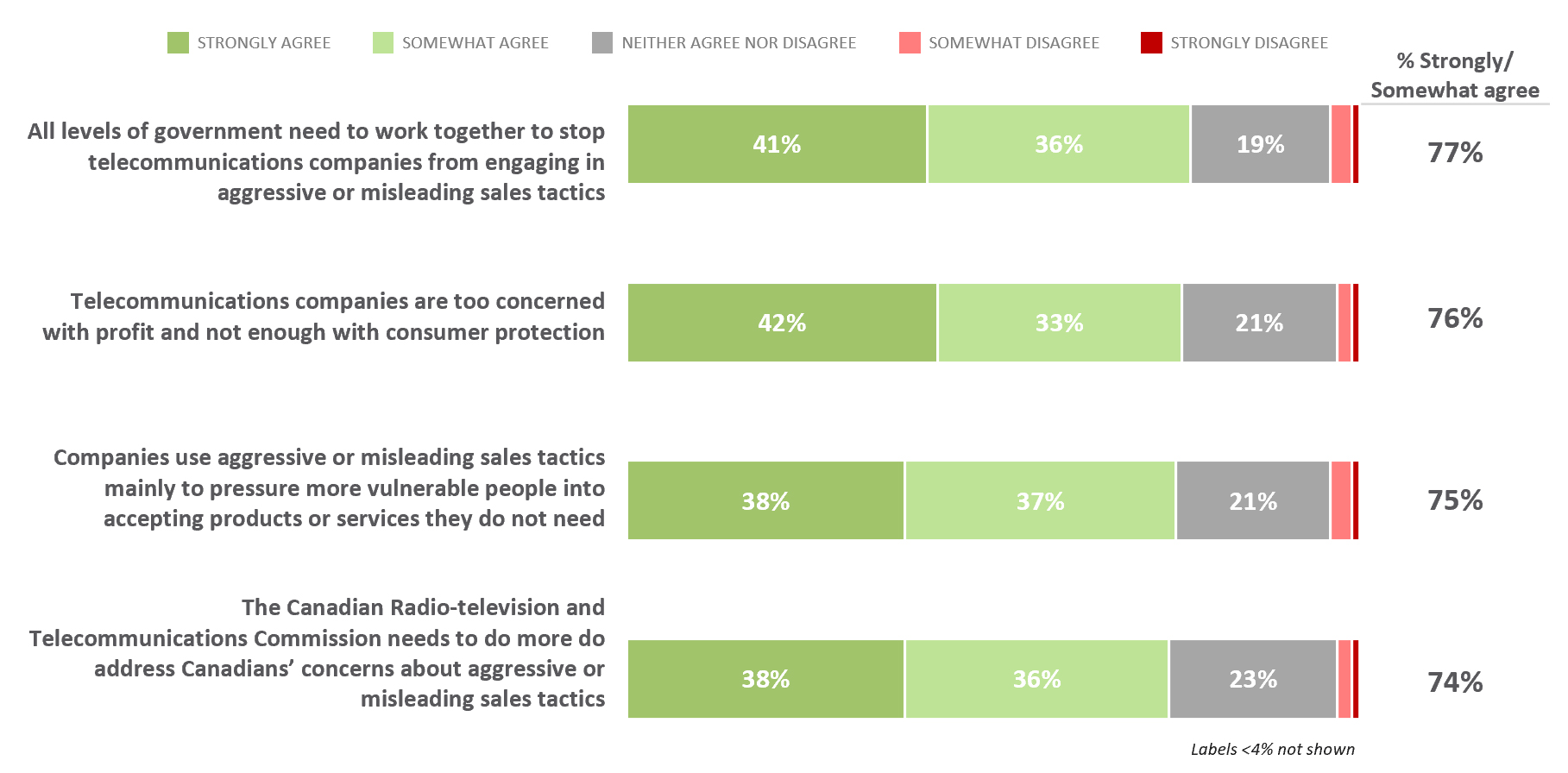
Base: All Respondents (n=1809)
Q22. Please indicate how much you agree or disagree with the following statements.
Attitudes and Opinions towards aggressive or misleading sales practices - text version
A strong majority of Canadians also agree that:
Comparatively, four in ten agree that all companies use aggressive or misleading sales tactics in some form and that it is a normal part of business (41%), while fewer feel that concern about aggressive or misleading sales tactics from telecommunications providers in Canada is exaggerated (30%).

Base: All Respondents (n=1809)
Q22. Please indicate how much you agree or disagree with the following statements.
Attitudes and Opinions towards aggressive or misleading sales practices - text version
This section addresses Canadians support or opposition to a series of potential solutions to complaints about aggressive or misleading sales practices on the part of telecommunications companies in Canada as well as awareness of the Commission for Complaints for Telecom-Television Services (CCTS).
At more than eight in ten, support is very strong among Canadians for each of proposed remedies.

Base: All Respondents (n=1809)
Q23. How much do you support or oppose the following actions being taken to try and address the increase in complaints?
Participants feel much helplessness in dealing with telecom companies. They do not believe they have any course of action to protect themselves, and so hearing about potential solutions during the course of the discussions was of tremendous interest.
“I feel like there should be one code for everyone, because otherwise you don’t know what people are doing and they should just be straightforward or as straightforward as possible. So if there’s one set of rules for everyone, I think that’s the better way to go.” – Third Language Montreal
“They just need to be held accountable for it. It’s one thing to have a code of ethics or a code of conduct, but what are the ramifications if they break it? You know, ‘gosh, you’ve been bad’, you know, so there has to be some sort of accountability and penalty applied or attached to it, and then I think that’s a great idea.” – Senior, Calgary
“I guess my concern is that they may explain it in such a manner that it is perfectly clear to person A but person B, because they are less educated or a little older, whatever, they don't understand it so when you say that it has to be made understandable, there's not one size fits all explanation here so how does anybody ascertain whether the person doing the calling has done whatever he or she had to do to make sure that the person being called understands it?” – Senior, Sault Ste. Marie
“I think it would be really great. I think most of the contracts that you get are in writing. My thing though is it would work so long as what was written up was written at a Grade 6 level, otherwise many people might not fully understand the contract anyway.” – Northwest Territories & Yukon
“I think something in writing, in pen and paper right in front of you is real compared to an idea which is not real, it's abstract.” – Senior, SSM
“My preference would be that the telecom provider would have to contact us. He can cancel at any time obviously but I just want. It's like when you join one of those things, here you get a free delivery for a month but if you don't cancel that program within the month then you're going to be charged $70. They are really relying on people remembering that the month has gone by and canceling it.” – Rural BC
“If it touches providers' pockets, I think it will change something, I think it's a good idea.” – Minority Language, Saint Boniface & Moncton
“But when they've collected a lot of fines, won't the cost of our packages go up? So it's us who will pay for the fines.” – Val D’Or
“Because if it’s public, the people will know. You can go check before you go see that company if they have a lot of problems with people.” – Minority Language Toronto
“[…] a complaint report of complaints received just make it subject to targeted complaints or targeted complaining so there is reason to doubt you know […]” – Rural Community BC
Although there is some awareness that the industry is regulated, most do not believe there are any regulations in place as it relates to pricing, and sales or marketing tactics. One participant was told that the reason for higher telecom prices in Canada is because of the regulatory demands placed on the provider by the CRTC.
“Some regulatory body, and it’s probably the CRTC, came out like a month ago and identified the big companies that we’re talking about as being aggressive and not providing fair service. Well, it didn’t change anything.” – Senior, Calgary
Most believe that the actions should be overseen by a neutral third party; this could be a government regulator or an independent body. Participants were leery of having industry itself or individual telecom providers oversee such an initiative. They believed that the telecommunications providers would look out for their own best interests over those of consumers.
“No, that’s like the fox in charge of the henhouse”. – Senior, Halifax
At three in ten (30%), a minority of Canadians have ever heard of the Commission for Complaints for Telecom-Television Services (CCTS) before taking the survey.
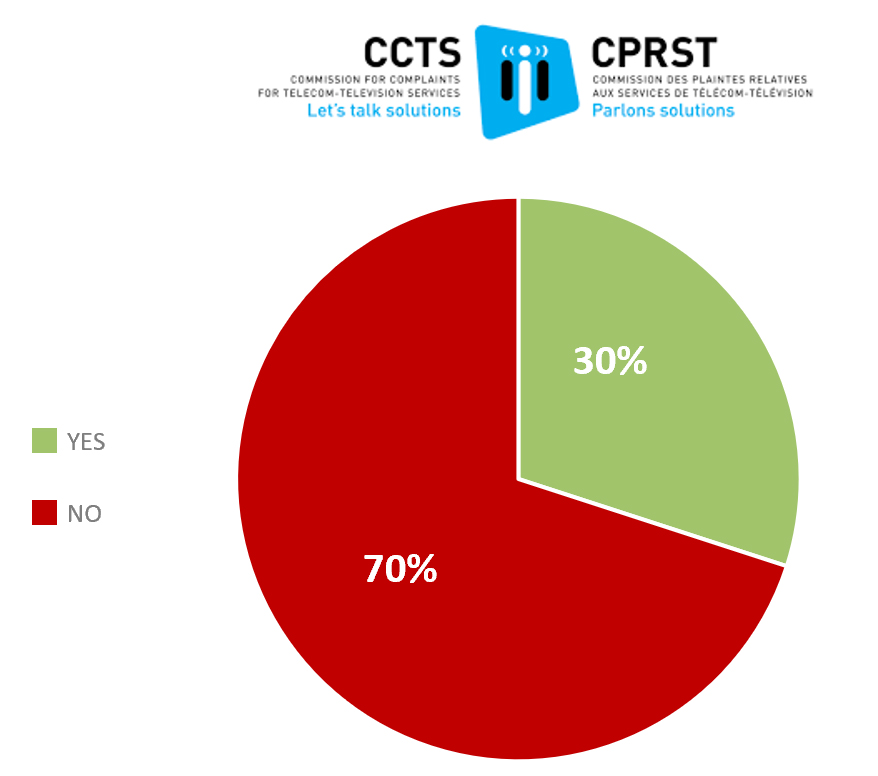
Base: All Respondents (n=1809)
Q20. Have you ever heard of the Commission for Complaints for Telecom-Television Services (CCTS) before taking this survey?
“The consumer can only complain if they know where to go”. – Senior, Calgary
“[I feel] a little better [knowing about CCTS], at least you can go there and find out where you can complain to, if nobody listened to you.” – Senior, Halifax
“I think that’s brilliant to have a commission for telecom services in this day in age, in Canada.” – Rural Community, BC
“This is new to me and it’s good to know there’s such a thing we can go and complain. Thank you.” – Third Language, Vancouver
An essential part of the POR commissioned by the CRTC was to ensure those groups more vulnerable to aggressive or misleading retail sales practices were included in the consultation to determine whether their experiences differed from those of other Canadians.
The audiences considered more vulnerable to aggressive or misleading retail sales practices include:
The quantitative panel survey provides sufficient sample sizes for analysis among Canadians with disabilities (n=338), Seniors (n=388) and Third language communities (n=195). The remaining, harder to reach, audiences were consulted through qualitative research which included sessions among all groups considered more vulnerable to aggressive or misleading sales practices.
Those who self-identify as having a disability (n=338) are more likely to report experiencing sales practices they consider aggressive or misleading than those who do not. They are also more likely to express concern with the cost of services charged by telecommunications providers.

Base: All Respondents (n=1809), Presence of disability (n=338), No disability (n=1416)
Prevalence of specific aggressive or misleading sales practices however is no higher among those with a disability and support for the potential solutions presented is also consistent with the broader Canadian population.
Differences in experience and level of concern among those with a disability - text version
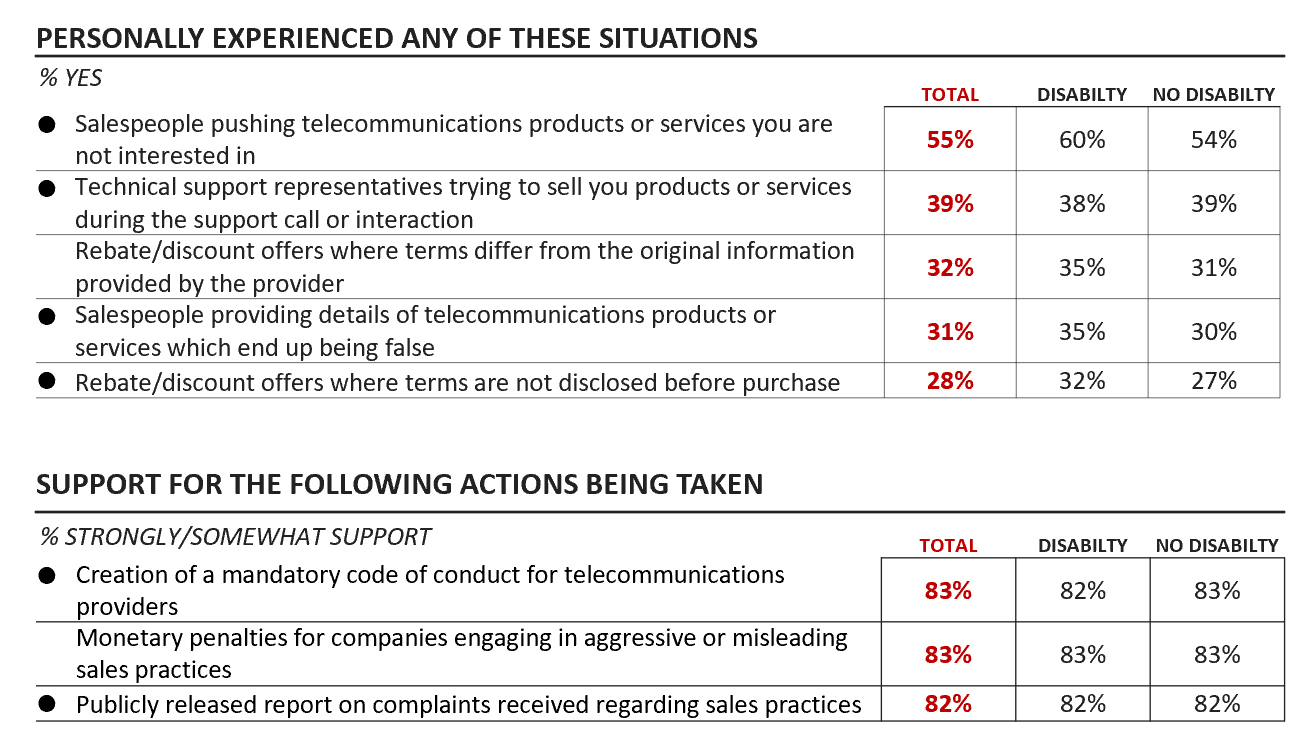
Base: All Respondents (n=1809), Presence of disability (n=338), No disability (n=1416)
Differences in experience and support for action among those with a disability - text version
Canadians over the age of 65 years old (n=388) are less likely to indicate having personally experienced aggressive or misleading sales practices both at the overall level and in regards to the specific types of sales practices asked about. Among those Seniors who have experienced aggressive or misleading sales practices, they are more likely to report it took place more than a year ago compared to the general population.
Despite the issue being somewhat less prevalence among this audience, Seniors are among the most likely to want to see all levels of government work together to address the issue and specifically to see action from the CRTC. Seniors are also more likely than the broader Canadian population to support the potential solutions presented.

Base: All Respondents (n=1809), Seniors (n=388)

Base: All Respondents (n=1809), Seniors (n=388)
Differences in experience, attitudes and support for action among Seniors - text version
Third language communities are defined as those who speak a language other than English or French most-often in the household (n=195). Respondents from a third language community are more likely to indicate personally experiencing aggressive or misleading sales practices overall (50% vs. 40% overall), while prevalence of specific aggressive or misleading sales practices is also higher for some activities including:
Respondents from a third language community also hold somewhat different attitudes towards aggressive or misleading sales practices than the broader population. They are less likely to agree that all levels of government need to work together to address the issue (Total: 77%, Third-language: 69%), that telecommunications companies are too concerned with profit and not enough with consumer protection (Total: 76%, Third-language: 69%) and that companies use these sales tactics to pressure more vulnerable people into accepting products or services they do not need (Total: 75%, Third-language: 66%). They are also more likely to agree that all companies use aggressive or misleading sales tactics and that it is a normal part of business (Total: 41%, Third-language: 51%) and that concern about the sales practices in Canada is exaggerated (Total: 30%, Third-language: 40%).
Support for potential remedies is lower among those who speak a third language however a strong majority are still in favour of each solution presented.
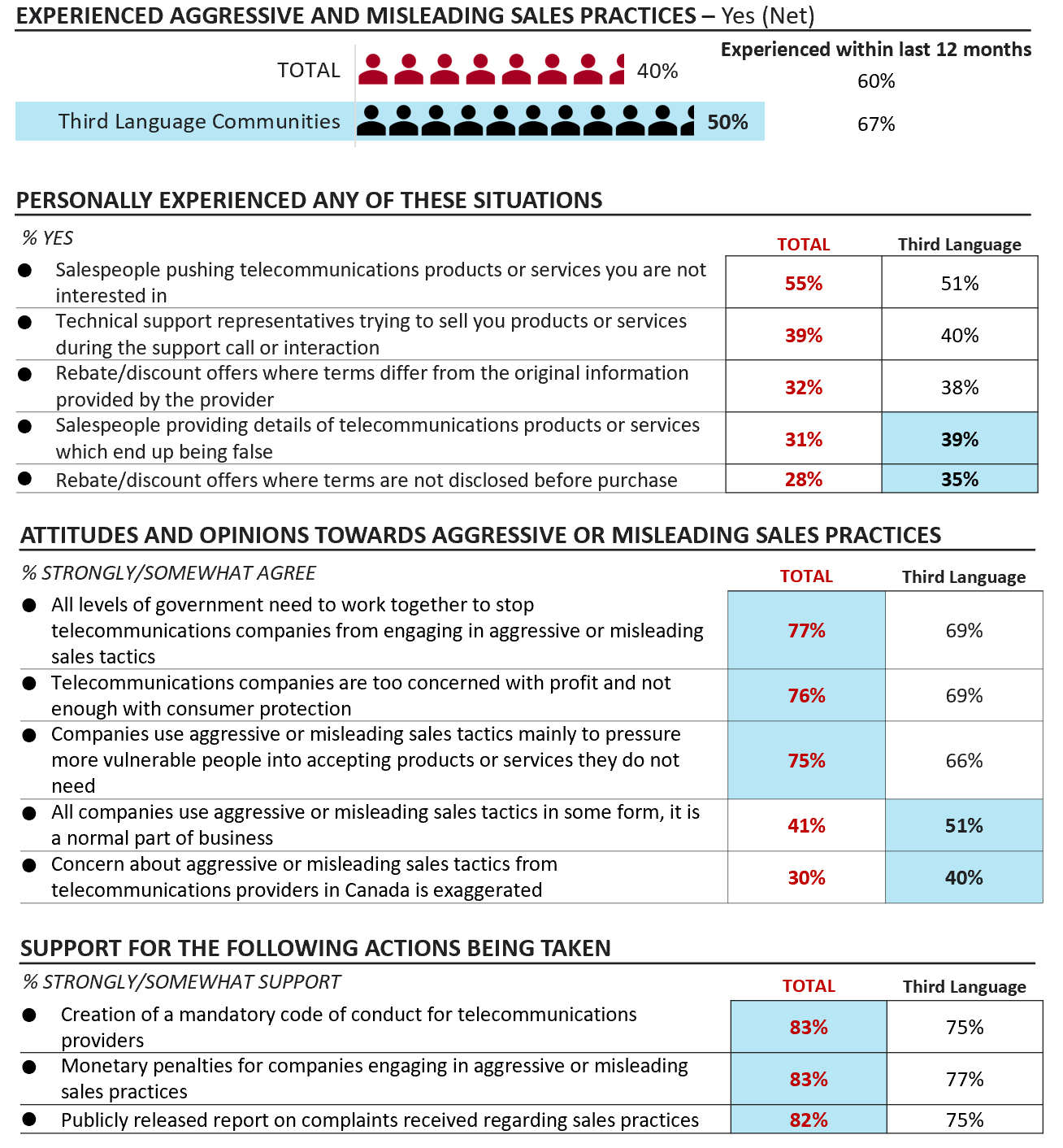
Base: All Respondents (n=1809), Third language communities (n=195)
While many were unaffected as part of a vulnerable population in their dealings with telecommunications providers, some themes emerged by group:
“I have sort of a funny story with respect to, you had mentioned, you know, people not understanding you. And I don’t know about Shaw, but I know Telus uses offshore a lot. My husband passed away and I phoned to cancel his cell phone. And it’s really, totally… it’s terrible. So, I got somebody on the line and I explained that, you know, my husband’s passed away and I need to cancel his phone. And he asked me a few questions and then he said: ‘Of course we can’t do this without your husband’s permission’. And I said: ‘he’s passed away’ and he said: ‘oh no, I’m terribly sorry’ and then he asked me some more questions and told me what I had to do, and then he said: ‘Is there any way you can get in touch with him?’ …And I wanted to say ‘the séance is Friday, but you know…’ And then he asked, you know, more things about where I need to take the phone … And then: ‘when do you expect him back?’ And I said: ‘the man is dead, dead, dead as a doornail, DEAD!’, and I go: ‘Oh my God’, and I was put on hold right away. And the next thing was a north American voice: ‘Mrs. F, I’m so sorry for your loss’.” – Senior, Calgary
“With anybody you deal with, you know, so if they’re going to have call centers and have them here or whatever, you know, I think that as Canadians we have the option of speaking French I guess. And I don’t speak French, but the two languages in Canada are English and French, and that’s my feeling on that.” – Senior, BC
“I called [Bell] one day in January and I think it was probably Mumbai or somewhere and they said that the leaves were blocking my satellite dish and I said, I don't know where you are but it's January.” – Senior, Sault Ste. Marie
“When I bought my cell phone – I don't know anything about this stuff – I go to Bell, I get a cell phone. The most basic package is for just making phone calls. But they give me the most complicated one, I don't understand any of it. On top of that, you try and do something with the phone and you don't manage (or at least I don't). When I went back to ask for their help, she said 'yes but madame, you should have told us, you've paid $400 for the contract, I could have offered you this (something simpler)'. And I said that was what I asked you for last time. Oh (big sigh). They sold me the big package, I took it, and now I'm stuck with it for 2 years.” – Senior, Val D’Or
“I’m openly autistic and I also have attention deficit disorder and so, with the fact that I am autistic, there are certain things where I have some sensory processing issues so you know, dealing with people on the phone sometimes, I get very frustrated and you know, it’s just a sensory input thing so I do my best to get through them and get things resolved but sometimes it’s just a bit too overwhelming for me. So, that’s why I don’t always follow- I don’t always fight it, like I was saying earlier.” – Person with Disability, BC
“[…]there are some days where like my body just doesn’t work and so it can be really hard to then have to deal with services not working. And having to call and speak with multiple people and try to like, they’re telling you to do like all these troubleshooting options and so that can be hard if my mobility is not great that day. And a lot of time I’ll have to be on oxygen, so that can make it really hard too, to have to be going up and down stairs and just doing all of these things that they’d like me to try to do. So yes, in that way it is frustrating for sure, it does add an extra layer of frustration.” – Person with Disability, NB
“My parents, you know, they’re not as fluent in English and I just find that a lot of the customer service representatives speak very fast. You know, I myself am in sales and I find that when you’re talking to different people you just have to listen to how they speak, and try and follow so that they can actually follow. So if they speak slowly, then you speak slowly so that they can understand. A lot of times I find the customer service reps are speaking so fast that even I have trouble […] So it’s just, you know, proper training where they can slow down to where the customer is.” – Third Language Toronto
“For me, that’s very important, customer service agents that speak English because a lot of times you can be redirected to the French-speaking ones, which is fine. I am bilingual, but if I’m going to get my point across and maybe I’m not happy with something, I need to speak in English.” – Minority Language Montreal
“[…]when cellphones first came out here in the Northwest Territories, there was only one provider. So they could charge whatever they wanted, and anybody that wanted a cellphone had to pay for it. It wasn’t until other cellphone providers started to creep into the NWT and start giving them a little bit of competition that the prices started to drop. When it first came out it was ten cents a text message. Now we have unlimited text messaging. But it wasn’t until other providers started to come in because of competition. So there’s not a lot of options here in the Northwest Territories, Yukon, and Nunavut.” – Northwest Territories & Yukon
“I find it's very expensive. If you compare with elsewhere, like Mont Laurier, just 3.5h from here. They pay half what we pay! It doesn't make sense.: - Val D’Or
This section addresses differences in responses by major telecommunications providers. Respondents were asked at the beginning of the survey to identify their provider for each of the primary telecommunications services they currently use (i.e. internet at home, cellphone, TV service and home phone). Those who indicated currently having at least one service with each of the major providers were then grouped and analyzed.
Sufficient sample sizes exist to analyze the panel survey data by the four largest providers: Rogers (n=509), Bell/Aliant (n=545), Videotron (n=332) and Telus (n=443), while all other providers have been grouped as other (n=1036).
The primary differences when analyzing responses by major provider are as follows:
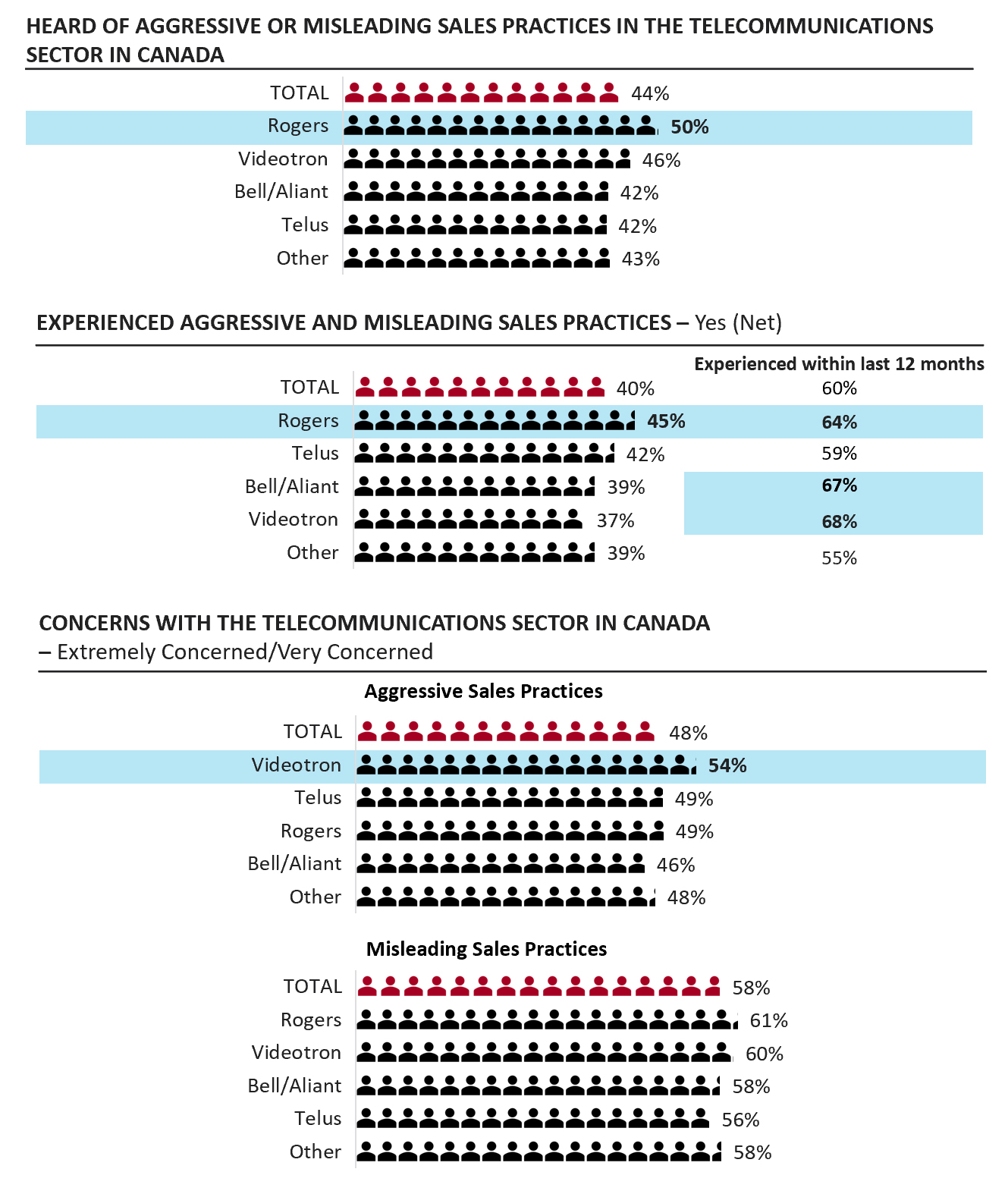
Base: All Respondents (n=1809), Rogers customers (n=509), Bell/Aliant customers (n=545), Videotron customers (n=332), Telus customers (n=443), Customers of other providers (n=1036)
Differences in awareness, experience and level of concern by major provider - text version
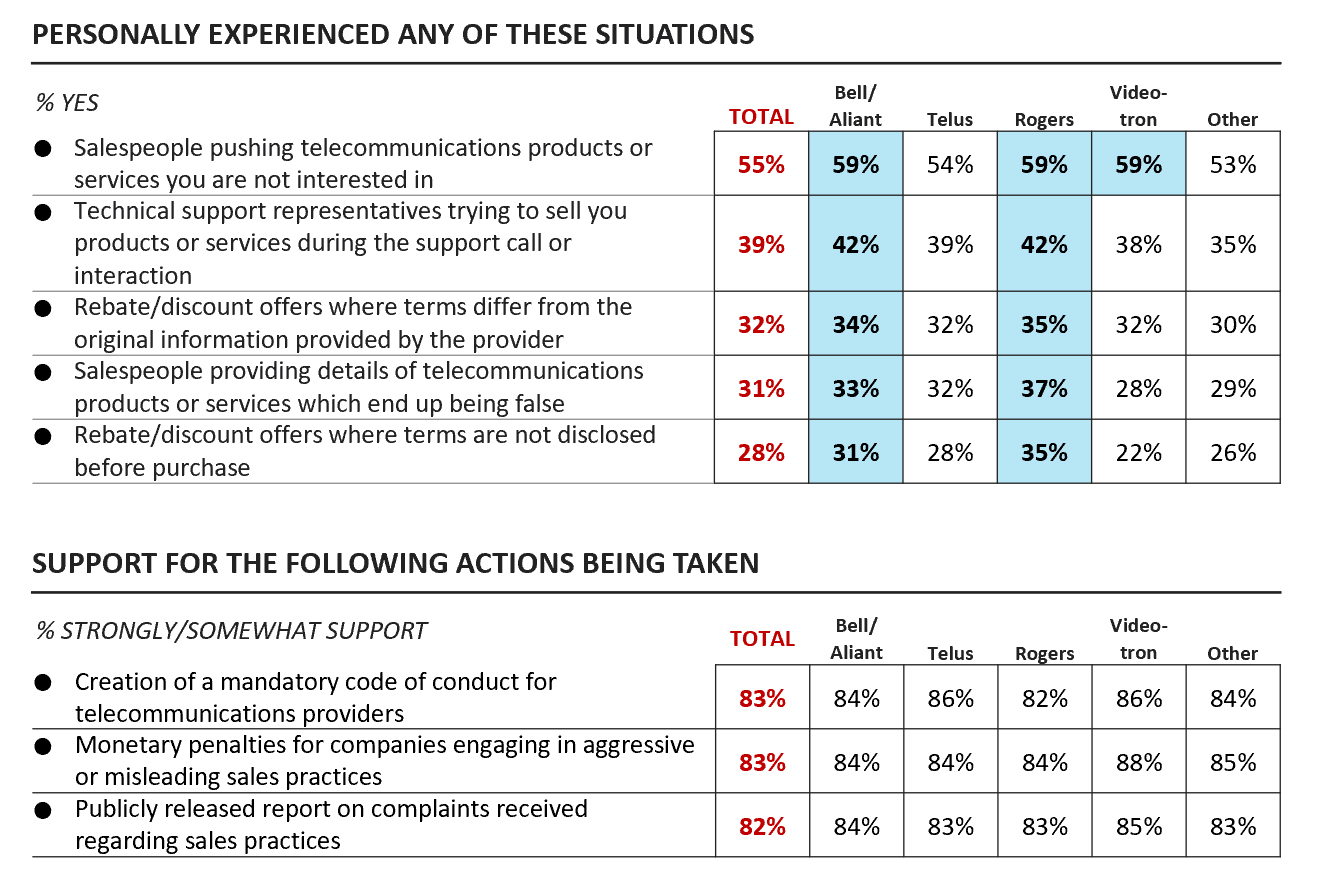
Base: All Respondents (n=1809), Rogers customers (n=509), Bell/Aliant customers (n=545), Videotron customers (n=332), Telus customers (n=443), Customers of other providers (n=1036)
Differences in experience and support for action by major provider - text version
This section addresses differences by demographic information. The demographic factors which were analyzed include age, gender, region of residence, Indigenous status and whether the respondent was born in Canada.
Experiences and attitudes towards aggressive or misleading sales practices in the telecommunications sector in Canada vary based on where in the country the individual resides. The primary differences by region of residence are as follows:
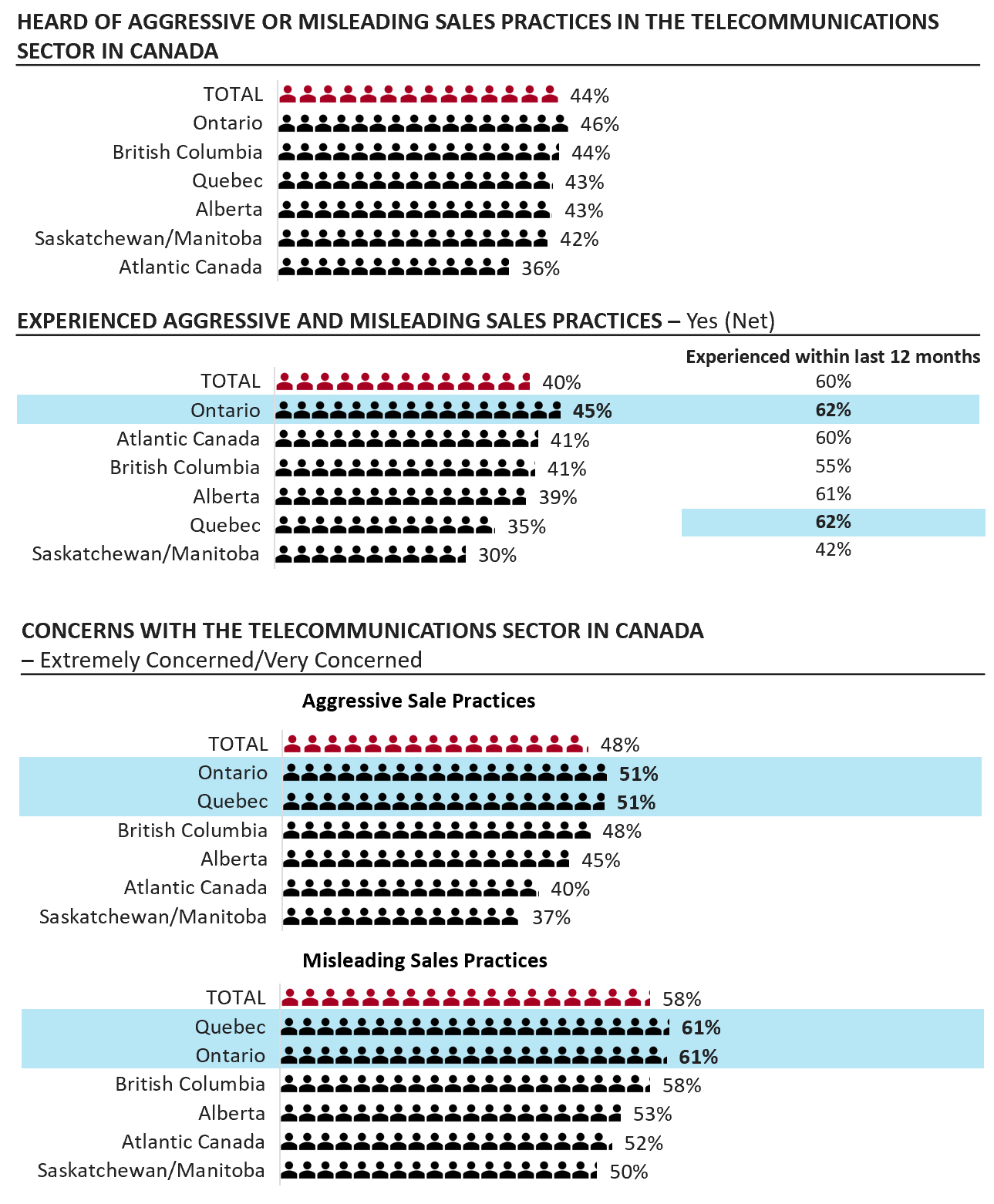
Base: All Respondents (n=1809), Ontario (n=611), Quebec (n=572), British Columbia (n=223), Alberta (n=175), Saskatchewan/Manitoba (n=110), Atlantic Canada (n=118)
Differences in awareness, experience and level of concern by region of residence - text version
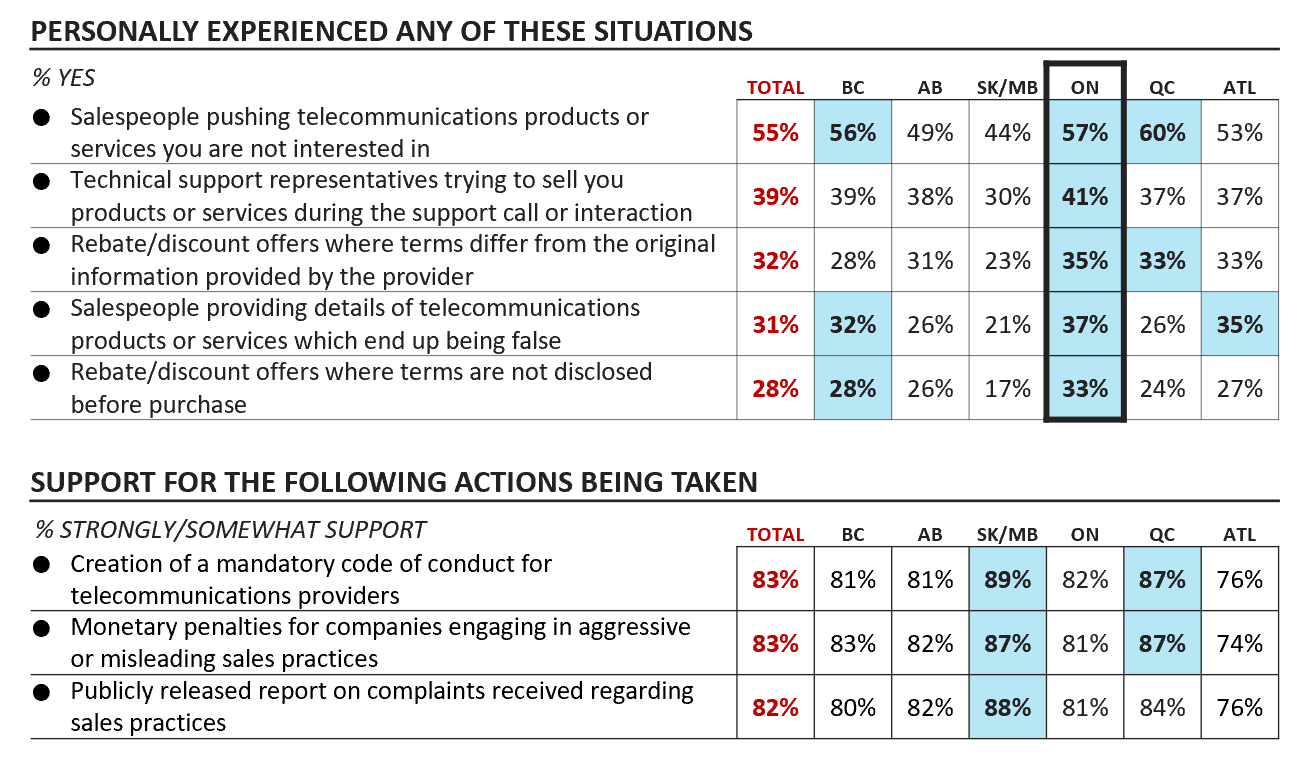
Base: All Respondents (n=1809), Ontario (n=611), Quebec (n=572), British Columbia (n=223), Alberta (n=175), Saskatchewan/Manitoba (n=110), Atlantic Canada (n=118)
Differences in experience and support for action by region of residence - text version
Experiences and attitudes towards aggressive or misleading sales practices differ somewhat depending on if the individual resides in an urban (n=1647) or rural area (n=162). Urban and rural have been defined by the postal code provided by each respondent for their residence and match Canada Post’s definition for a rural route delivery area. Rural route delivery areas are classified by those postal codes which have a “0” in second position. The primary differences between Canadians who live in urban or rural areas are as follows:
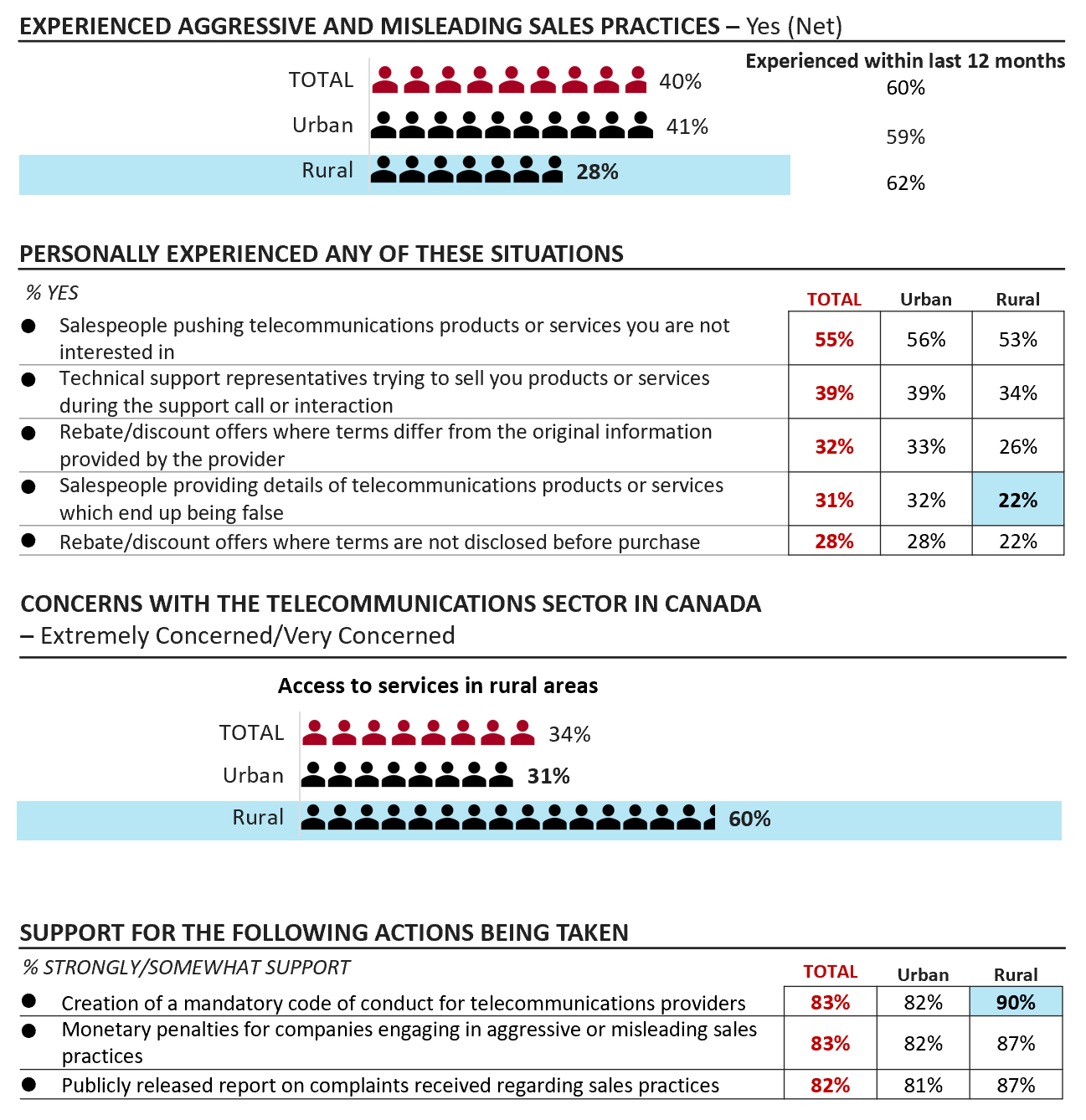
Base: All Respondents (n=1809), Urban (n=1647), Rural (n=162)
Differences in experience, level of concern and support for action by Urban/Rural - text version
We observed several differences in experience and attitude when analyzing the data by age cohort. The primary differences by age of respondents are as follows:
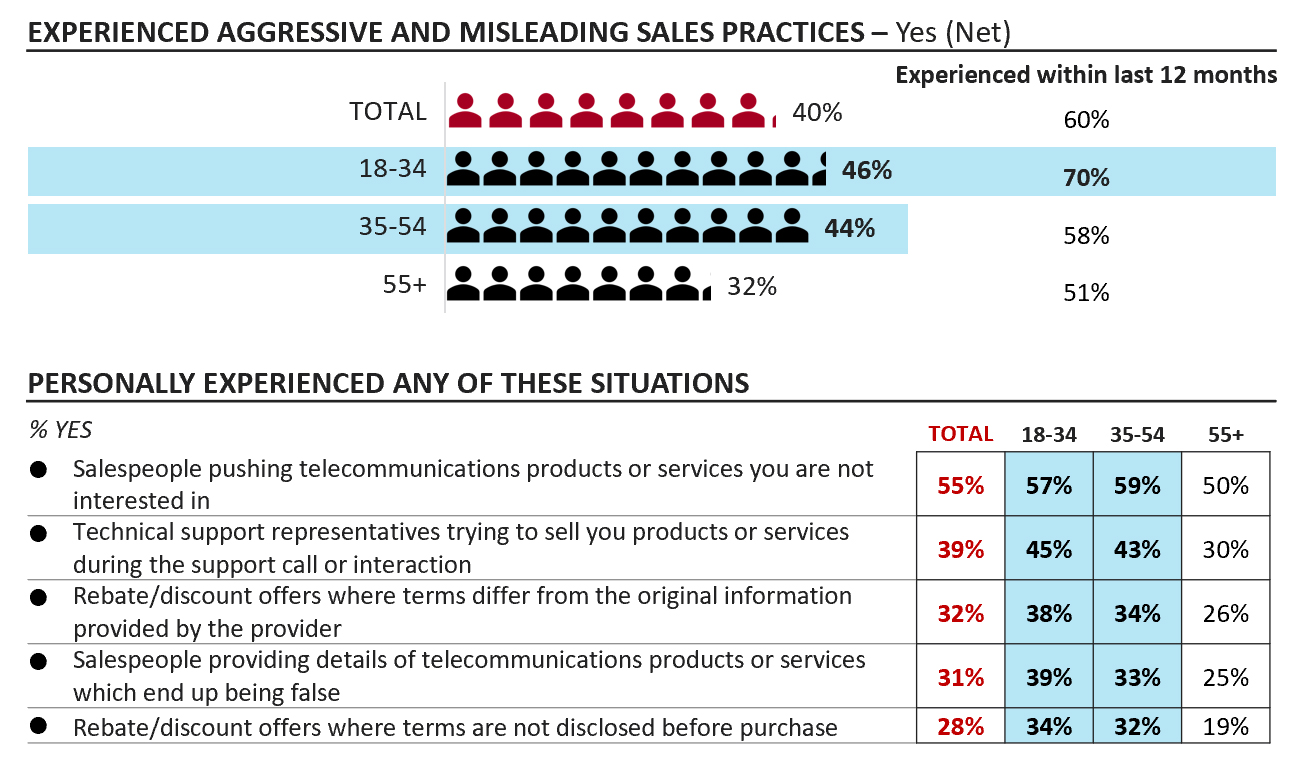
Base: All Respondents (n=1809), 18-34 (n=469), 35-54 (n=621), 55+ (n=719)

Base: All Respondents (n=1809), 18-34 (n=469), 35-54 (n=621), 55+ (n=719)
Differences in support for action by age cohort - text version
While the sample size of those who self-identify as indigenous is relatively small (n=58) some trends are evident across key measures when analyzing results by this audience.
Awareness of the issue of aggressive or misleading sales practices is higher among Indigenous respondents and they are more likely to indicate having experienced such sales practices both overall and among the specific types asked about.
Indigenous respondents are also more likely to express concern with access to services in rural areas and less likely to feel concerned regarding the cost of services in the telecommunications sector in Canada.
Despite being more likely to have experienced aggressive or misleading sales practices, support for the potential remedies is lower than the general population but remains high with a strong majority in support of each solution presented.
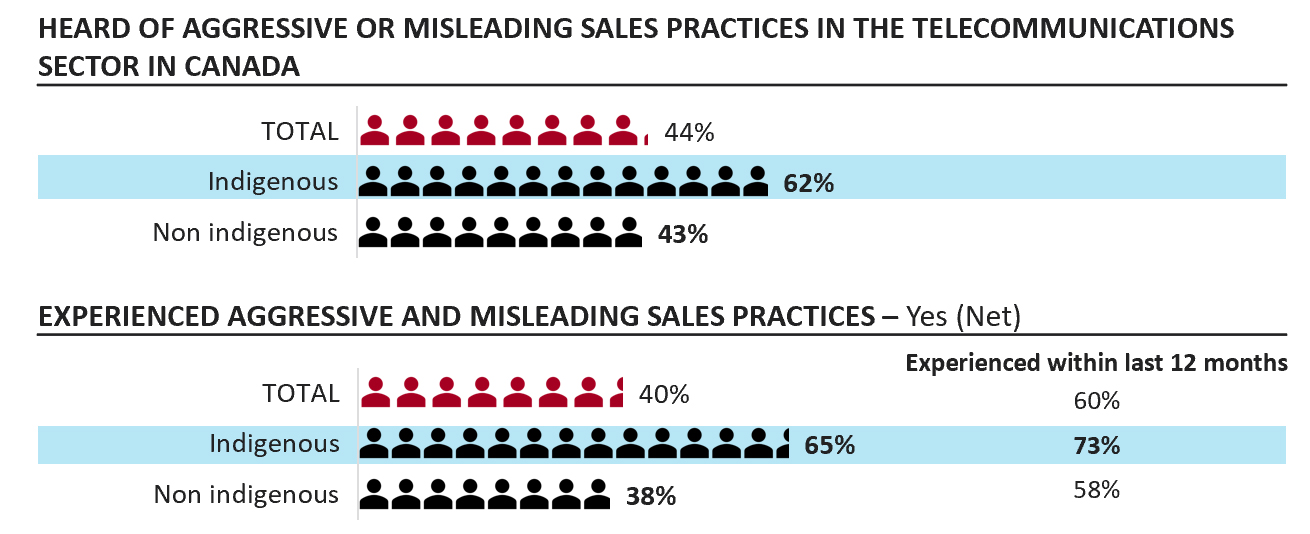
Base: Respondents Born in Canada (n=1478), Indigenous (n=58), Non Indigenous (n=1420)
Differences in awareness and experience by Indigenous status - text version
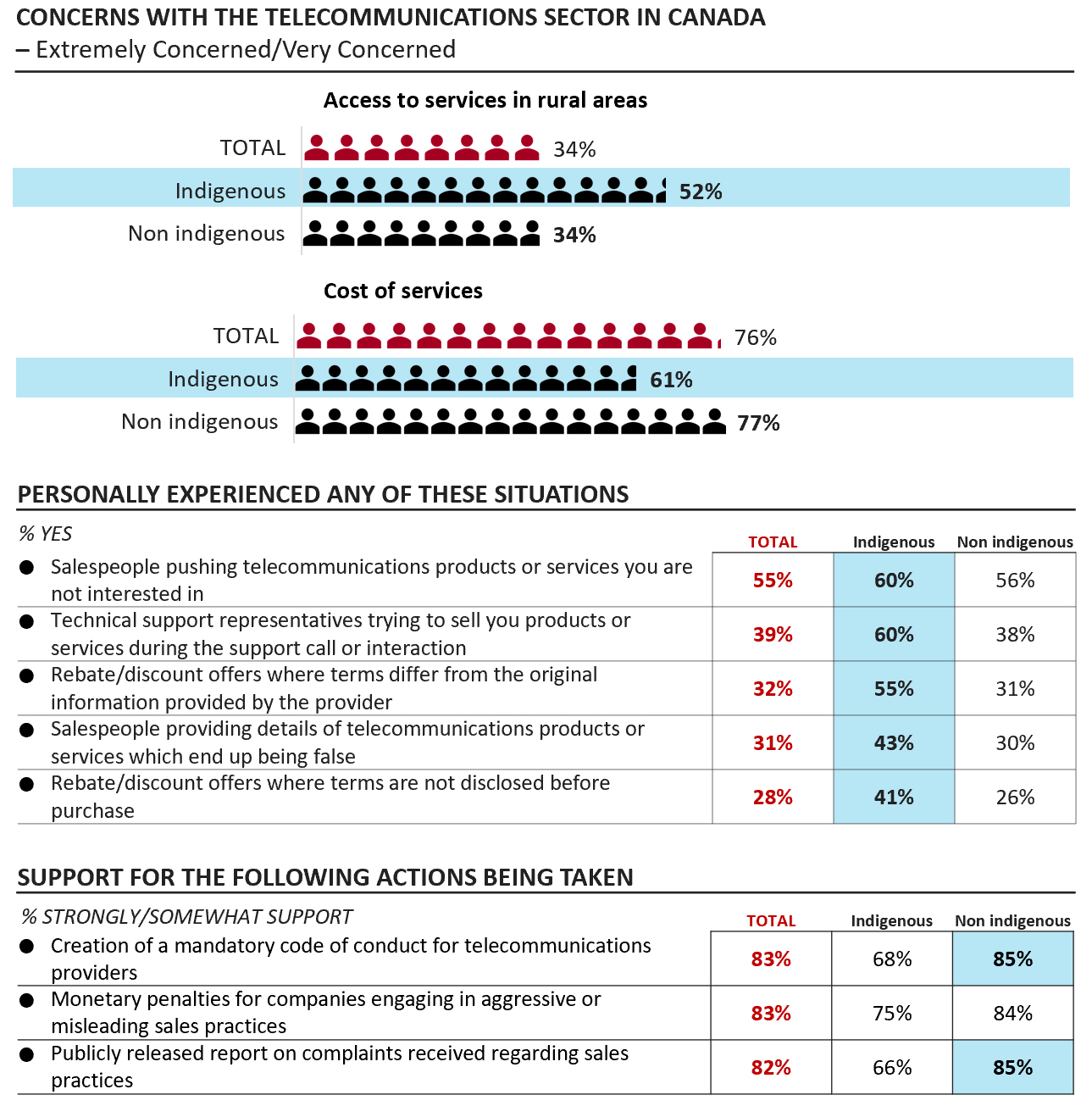
Base: Respondents Born in Canada (n=1478), Indigenous (n=58), Non Indigenous (n=1420)
Those not born in Canada (n=331) are no more or less likely to have experienced aggressive or misleading sale practices than those born in the country but have some differences of opinions expressing greater tolerance towards the tactics than those born in the country.
Respondents not born in Canada are less likely to agree that telecommunications companies are too focused on profit and not enough on consumer protection and more likely to agree that all companies use such sales practices and they are a normal part of business and that concern about the tactics is exaggerated compared to those born in Canada. They are also less likely to be supportive of the potential solutions than those born in Canada however a strong majority support each of the remedies presented.
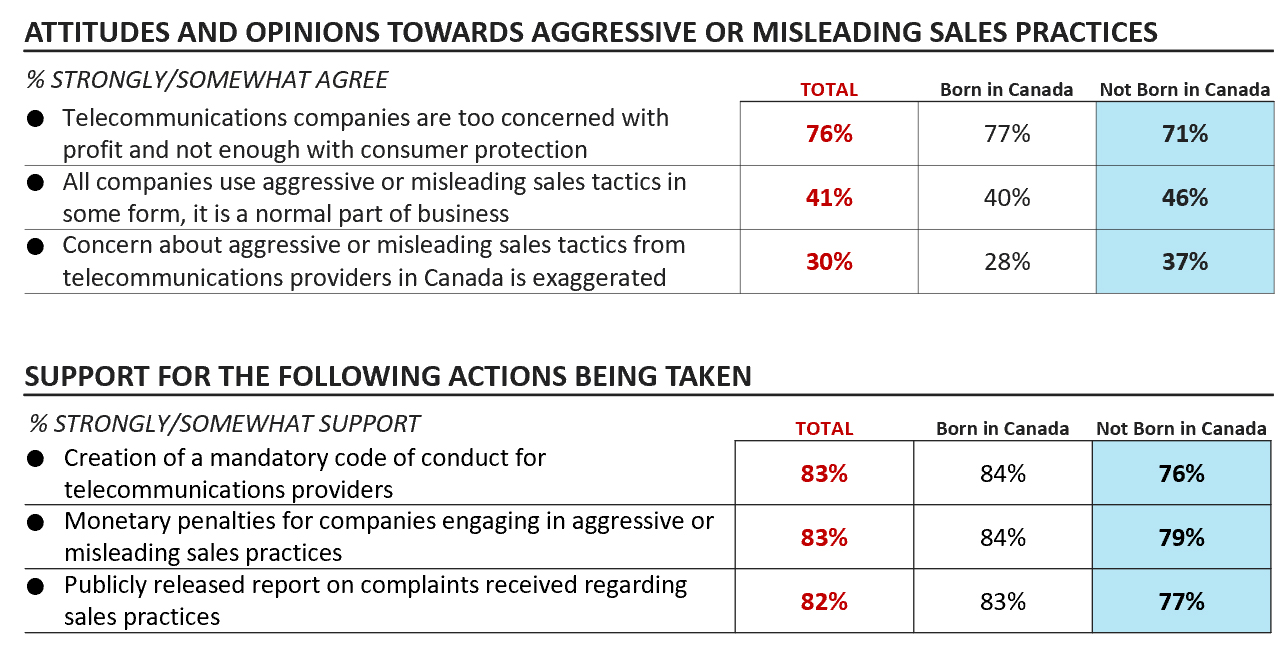
Base: All Respondents (n=1809), Born in Canada (n=1478), Not Born in Canada (n=331)
Differences in attitudes and support by Born in Canada - text version
This section addressed differences by Official Language and data has been analyzed by those who speak (n=1180) or French (n=570).
The primary differences by Official Language are as follows:
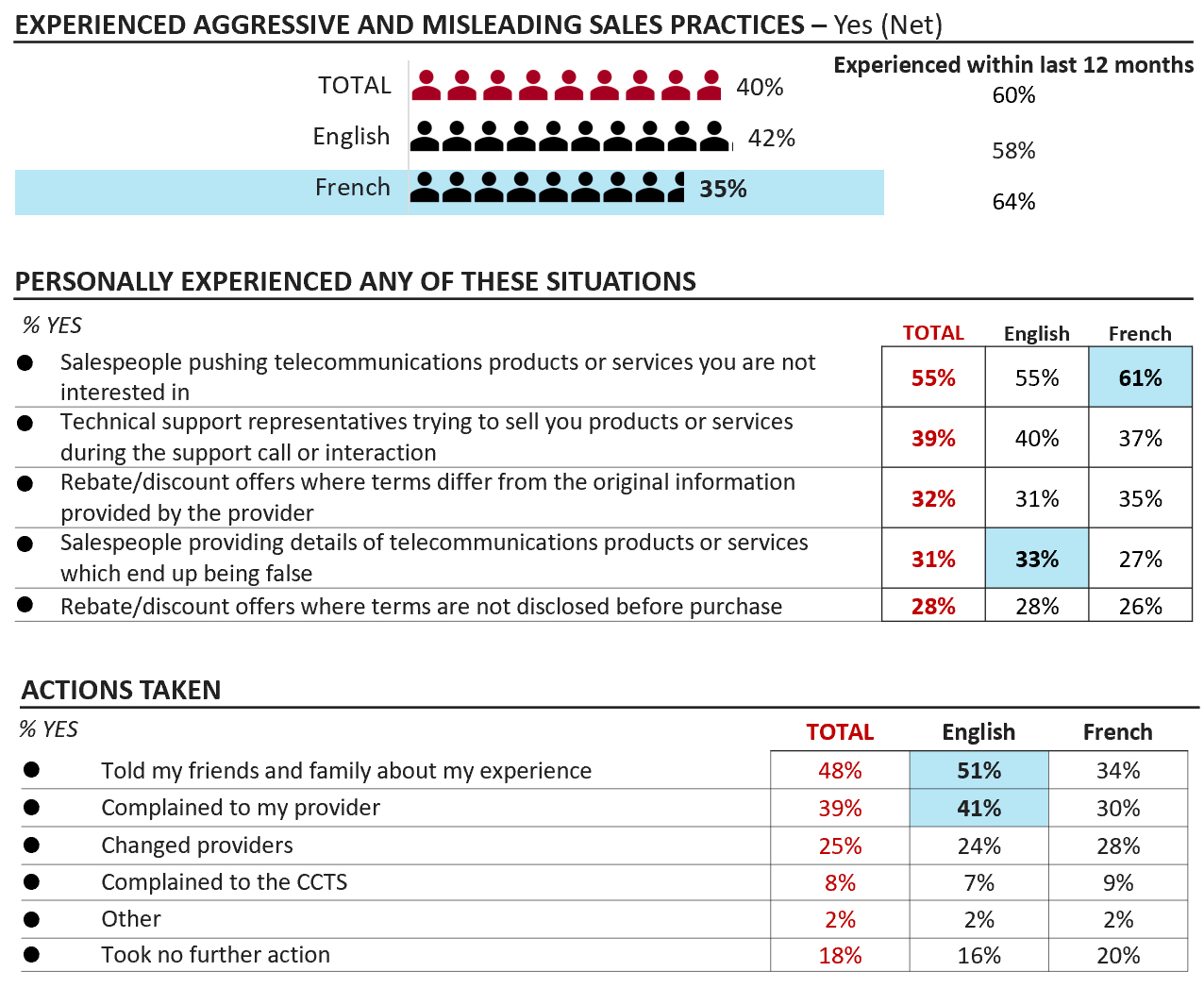
Base: All Respondents (n=1809), English (n=1180), French (n=570); Experienced aggressive or misleading sales practices (n=711), English (n=493), French (n=197)
Differences in experience by Official Language - text version

Base: All Respondents (n=1809), English (n=1180), French (n=570)
Differences in attitudes and support for action by Official Language - text version
This section addresses differences in responses between the panel and voluntary public survey.
In order to allow the Canadian public to participate in the consultation process a separate voluntary version of the survey was executed and made available through the CRTC’s website and social media channels. In total, n=7075 responses were received to the voluntary public survey.
Those who responded to the voluntary survey are more likely to be male (66%), 25-44 years old (43%) and from Alberta (20%) or Quebec (32%) compared to the actual proportions of the Canadian population. A full detailed profile of respondents to the voluntary survey can be found in the appendix of this report.
The primary differences in responses are that those who completed the voluntary survey are much more likely to have heard of aggressive or misleading sales practices in the telecommunications sector in Canada (87% voluntary survey vs. 44% panel survey) and to report having it personally both at the overall level (80% vs. 40%) and in regards to specific situations presented including:
Those who completed the voluntary survey are also more likely to express a high-level of concern (% extremely concerned) with the telecommunications sector across all areas presented of which the gap in attitudes is largest for concern with the amount of competition in the sector (59% vs. 19%), cost of services (83% vs. 48%) and misleading sales practices (59% vs. 30%).
Among those who experienced aggressive or misleading sales practices, respondents to the voluntary survey are more likely to have told friends and family (62% vs. 48%) and to have changed providers (31% vs. 25%), while those who responded to the panel survey are more likely to have complained to their provider (39% vs. 31%) or complained to the CCTS (8% vs. 4%).
Respondents to the voluntary survey are also much more likely to support action to be taken to address the issue of misleading or aggressive sales practices and in particular to ‘strongly support’ each potential solution presented by nearly a 20-point margin.
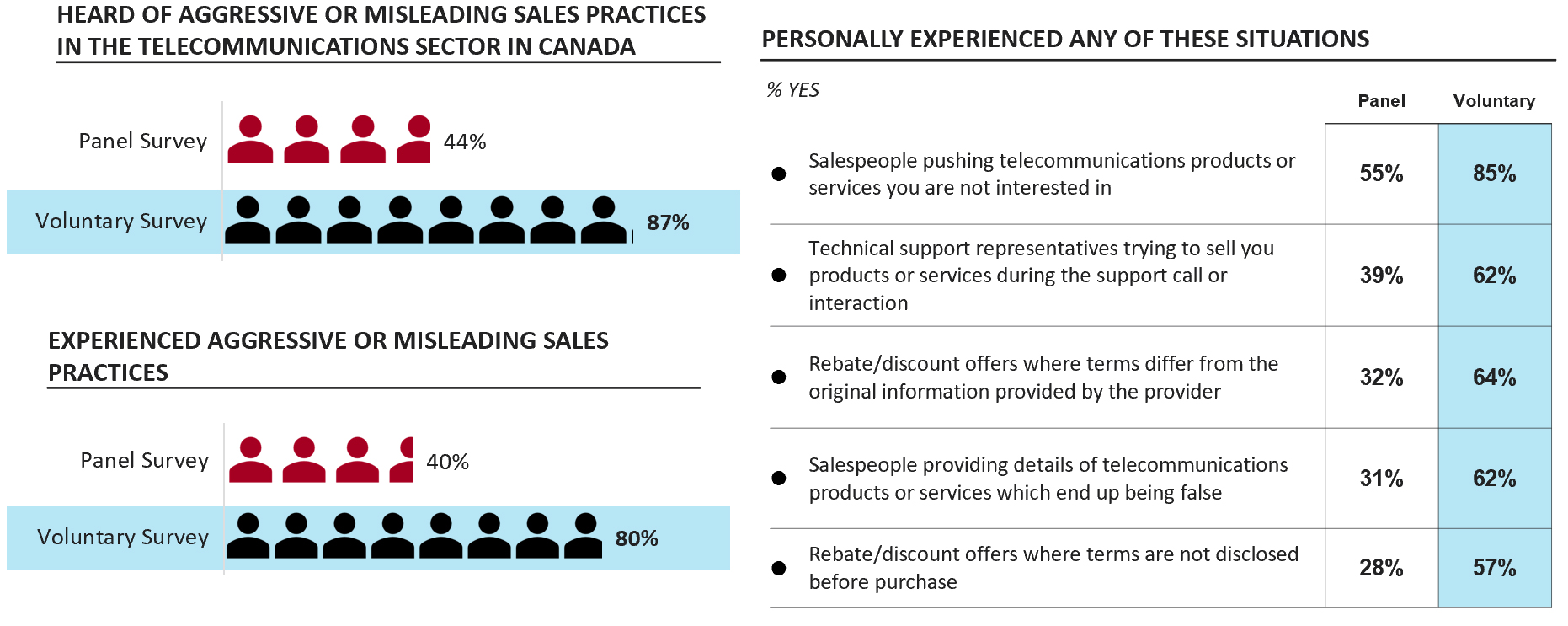
Base: Panel survey (n=1809), Voluntary survey (n=7075)
Comparison between panel/voluntary survey by awareness and experience - text version
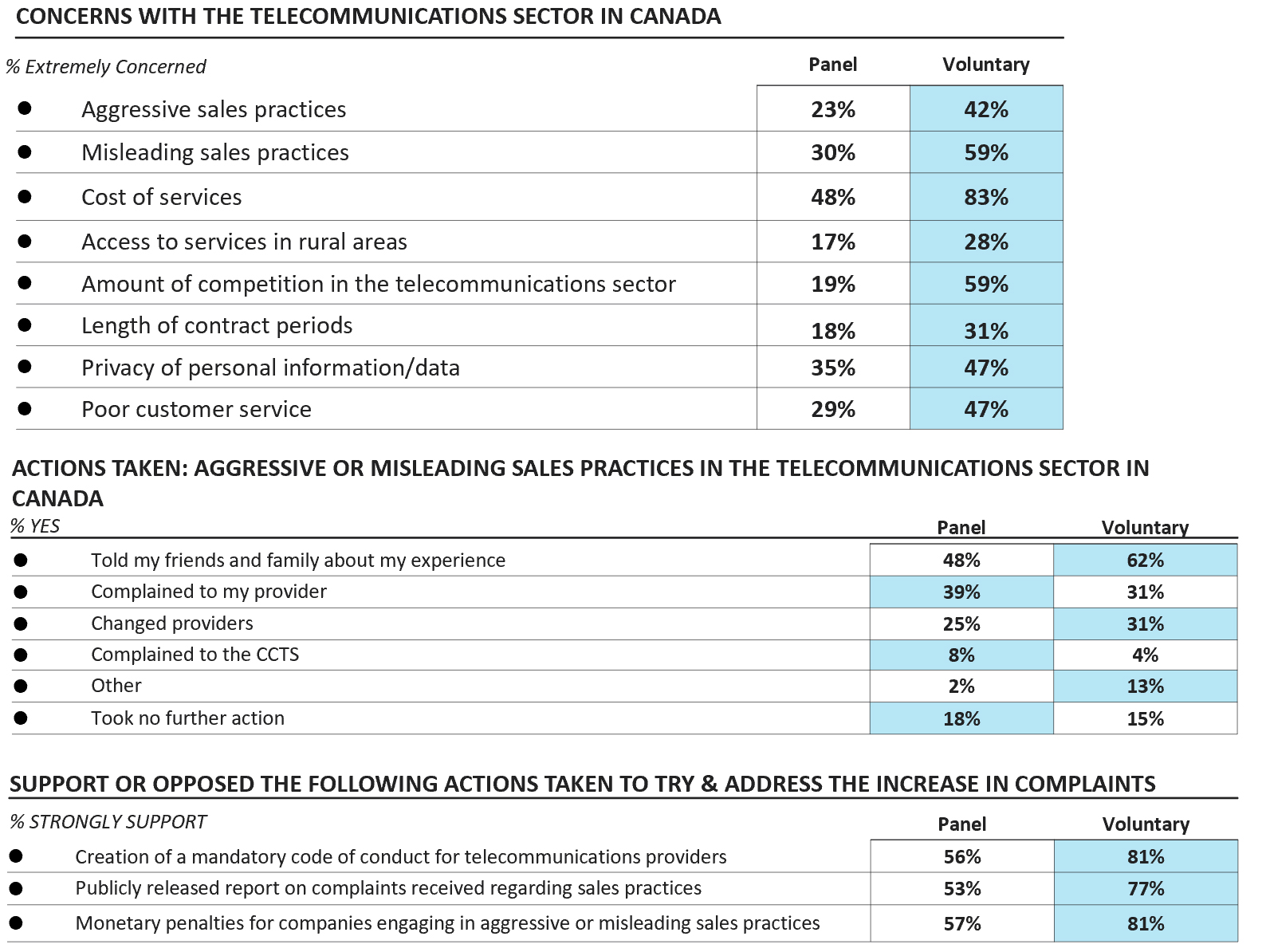
Base: Panel survey (n=1809), Voluntary survey (n=7075); Experienced aggressive or misleading sales practices Panel survey (n=711), Voluntary survey (n=5677)
Comparison between panel/voluntary survey by level of concern and support for action - text version
The demographic characteristics of the surveyed populations from the panel and voluntary surveys are presented below. Data presented in the tables below for the panel survey are weighted proportions.
| Age | Panel survey | Voluntary survey |
|---|---|---|
| 18-24 | 11% | 4% |
| 25-34 | 16% | 22% |
| 35-44 | 16% | 21% |
| 45-54 | 19% | 16% |
| 55-64 | 17% | 19% |
| 65+ | 21% | 18% |
| Gender | ||
| Male | 49% | 66% |
| Female | 51% | 34% |
| Region | ||
| British Columbia | 14% | 10% |
| Alberta | 11% | 20% |
| Saskatchewan | 3% | 2% |
| Manitoba | 4% | 2% |
| Ontario | 37% | 28% |
| Quebec | 23% | 32% |
| New Brunswick | 2% | 2% |
| Nova Scotia | 3% | 2% |
| Prince Edward Island | 1% | - |
| Newfoundland and Labrador | 2% | 2% |
| Income | ||
| <$40,000 | 22% | 17% |
| $40,000-<$60,000 | 18% | 15% |
| $60,000 - <$100,000 | 26% | 24% |
| $100,000+ | 23% | 25% |
| Prefer not to say | 11% | 19% |
| Born in Canada | ||
| Yes | 81% | 86% |
| No | 19% | 14% |
| Indigenous Status | ||
| Indigenous | 4% | 3% |
| Non Indigenous | 96% | 97% |
| Presence of Children Under 18 in Household | ||
| Yes | 28% | 26% |
| No | 72% | 74% |
Ipsos conducted a 10-minute online survey among a sample of n=1809 Canadians aged 18 years and older (n=1603 general population with an oversample of n=206 French-speaking respondents) stratified to the actual proportion of the Canadian population based on the 2016 Census by age, gender and region. Fieldwork was conducted between Monday, August 27th and Sunday, September 9th, 2018.
The survey was administered among a general public audience using panel-based resources for data collection and included sample from Research Now panel. Respondents for this survey were selected from among those who have volunteered to participate in online surveys. The panel provides a number of innovative incentive programs to participants tailored to the specific requirements of each survey, depending on the length of the survey, the subject matter of the study, and the time required to complete a minimum number of interviews. A point-based system is used where participants can redeem points for various items.
Weighting has been applied to ensure that the sample proportions match the characteristics of the population according to the 2016 Census, by age, gender, and region. Ipsos does not calculate a margin of error for online surveys because online surveys are considered non-probabilistic. A credibility interval is used instead. The credibility interval for a sample of this size of ± 2.8% in 19 cases out of 20.
The table below compares the unweighted sample to the 2016 Census results by region, age, and gender, as well as the weighted geographical and demographic distribution of the sample.
| Definition | Unweighted Sample size | Sample proportions | Census 2016 Proportions |
|---|---|---|---|
| Age | |||
| 18 - 24 | 197 | 11% | 11% |
| 25 - 34 | 280 | 16% | 16% |
| 35 - 44 | 294 | 16% | 16% |
| 45 - 54 | 324 | 19% | 18% |
| 55 - 64 | 329 | 17% | 17% |
| 65+ | 386 | 21% | 21% |
| Gender | |||
| Male | 877 | 49% | 49% |
| Female | 932 | 51% | 51% |
| Region | |||
| Prince Edward Island | 9 | 1% | >1% |
| Nova Scotia | 47 | 3% | 3% |
| New Brunswick | 31 | 2% | 2% |
| Quebec | 574 | 23% | 23% |
| Ontario | 608 | 37% | 38% |
| Manitoba | 63 | 4% | 4% |
| Saskatchewan | 47 | 3% | 3% |
| Alberta | 176 | 11% | 11% |
| British Columbia | 223 | 14% | 14% |
| Newfoundland and Labrador | 31 | 2% | 2% |
The following table provides the response dispositions and response rate calculation, as per the MRIA’s empirical method of calculating response rates for telephone surveys, with definitions extended to the online survey.
| Calculation for Panel Survey | # |
|---|---|
| Total Email Invitations Issued | 14572 |
| Unresolved (U) (no response) | 12001 |
| In-scope - non-responding (IS) | 203 |
| Qualified respondent break-off (incomplete) | 203 |
| In-scope - Responding units (R) | 2368 |
| Over quota | 100 |
| Other disqualified | 459 |
| Completed Interviews | 1809 |
| Response Rate = R/(U+IS+R) | 16% |
There exists within the current sample the possibility of non-response bias. In particular, this survey would not include members of the population who do not have access to the Internet (either via a personal computer or mobile device) or who are not capable of responding to a survey in either English or French. In addition, some groups within the population are systemically less likely to answer surveys. Variations in proportions have been corrected in the weighting to reflect 2016 Canadian Census values.
Ipsos conducted a 10-minute online survey among a sample of n=7075 respondents. Fieldwork was conducted between Monday, August 27th and Sunday, September 9th 2018. The survey was voluntary and made public through the CRTC’s website and social media channels. The survey was executed through Ipsos’ online survey platform and the only restriction placed on participating was an IP restriction meaning that only one completed survey could be received per IP address. The voluntary public survey is not intended to be representative of the broader Canadian population. A response rate and analysis of non-response bias cannot be completed due to the voluntary nature of the survey.
Ipsos conducted a series of 10 focus groups (4 in-person and 6 online) as well as 10 in-depth interviews among a variety of audiences considered more vulnerable to aggressive or misleading sales practices.
Details of each qualitative session including fieldwork dates, number of participants and incentives provided are detailed in the table below.
| Description | Details | # of participants | Fieldwork Dates | Incentive |
|---|---|---|---|---|
| Seniors | 2 focus groups in urban centres (Calgary & Halifax) 2 focus groups in small/rural communities (Val-D’Or & Sault Ste Marie) |
32 in total (8 per session) |
|
$100 per participant |
| Individuals with disabilities | 10 in-depth telephone/online-chat interviews | 10 in total |
|
$175 per participant |
| General public in rural communities | 1 online focus group in Whitehorse, Yukon 1 online focus group in Prince George, BC |
17 in total (7 in Yukon, 10 in BC) |
|
$100 per participant |
| Third language spoken at home | 1 online focus group in Toronto, ON 1 online focus group in Vancouver, BC |
19 in total (10 in Toronto, 9 in Vancouver) |
|
$100 per participant |
| Official language minority community | 1 online focus group in Saint Boniface, MB and Moncton, NB 1 online focus group in Montreal, QC |
17 in total (8 in MB, 9 in Montreal) |
|
$125 per participant |
It should be noted that the qualitative findings are not generalizable to a larger population, and that they should be considered directional only.
1. What is your date of birth?
Year
Month
[Terminate if under 18 years old]
2. What is your gender?
3. What is your postal code? (example: A8A 8A8)
[Ask Q4 for panel survey only]
4. In which industries or professions do you, or any member of your immediate household, work? Please select all that apply.
[If 1, 9, 15 terminate, otherwise continue]
[Ask Q5 for both open-link and panel survey. for panel survey, if yes to code 9 at Q4 ask Q5]
5. Do you, or any member of your immediate household, work for any of the following organizations? Please select all that apply.
[If none of the above continue, otherwise terminate]
6. Which of the following telecommunications and television services do you currently have for your personal use? Please select all that apply.
[If none of the above skip to Q13]
[Ask Q7 if cellphone selected at Q6]
7. Which of the following is your current cellphone provider? Please select only one.
[Randomize list]
[Ask Q8 if internet selected at Q6]
8. Which of the following is your current internet provider? Please select only one.
[Randomize list]
[Ask Q9 if TV service selected at Q6]
9. Which of the following is your television provider? Please select only one.
[Randomize list]
[Ask Q10 if home phone selected at Q6]
10. Which of the following is your home phone provider? Please select only one.
[Randomize list]
11. Are you currently on contract with your service provider for any of these services? (i.e. multi-year commitment)
[Insert response selected at Q6]
[If more than one selected at Q6 ask Q12]
12. Do you bundle any of these services with one service provider (i.e. purchase more than one product or service with one provider sold as a single combined product/plan)?
[Ask Q13 for panel survey only]
13. What, if anything, have you heard about the telecommunications sector in the past year?
[Insert text]
14. How concerned are you about each of the following in the telecommunications sector in Canada? Please provide one response per item.
[Rows][Randomize]
[Columns]
15. Before today, have you heard anything about aggressive or misleading sales practices in the telecommunications sector in Canada?
16. Have you ever experienced any sales practices you would consider aggressive or misleading from telecommunications providers in Canada?
[If yes, once before or yes, on more than one occasion at Q16, ask Q17, Q18 and Q19, otherwise skip]
17. When did you last experience this situation?
[Ask Q18 for panel survey only]
18. What did you experience? Please be as specific as possible
[Text box]
19. What, if anything, did you do about it? Please select all that apply.
[Randomize]
20. Have you ever heard of the Commission for Complaints for Telecom-Television Services (CCTS) before taking this survey?
[Show on separate screen after Q17] The Commission for Complaints for Telecom-Television Services (CCTS) is an independent industry-funded agency dedicated to resolving customer complaints about Canadian telecommunications and television service providers.
21. Have you ever personally experienced any of these situations? Please select all that apply.
22. Please indicate how much you agree or disagree with the following statements. Please provide one response per item.
[Randomize]
23. How much do you support or oppose the following actions being taken to try and address the increase in complaints? Please provide one response per item.
[Ask Q24 for panel survey only]
24. Are there any other comments you would like to share?
[Text box]
Demographic questions
We have a couple final questions for statistical classification purposes. Please indicate the answer that best describes you. Be assured that your responses will be held in strict confidence.
25. Have you ever been an employee of a telecommunications company in Canada?
26. What was your total household income, before taxes, in 2017?
27. Are there any children 18 years or younger living in your household?
28. Were you born in Canada?
[If yes at Q28 ask Q29]
29. Do you self-identify as an Indigenous person?
30. What is the language you use most often at home? If you use more than one language at home, please select the two most used languages.
[Insert list and allow two responses only]
31. Does any of the following currently apply to you? Please select all that apply.
Thank you. Those are all the questions we have for your today. We greatly appreciate your participation in this research.
| Welcome and Introduction | 5 Minutes |
| Section 1: Context | 15 Minutes |
| Section 2: Sales and Marketing Tactics | 45 Minutes |
| Section 3: Reactions to Potential Solutions | 20 Minutes |
| Wrap-up and Final Questions | 5 Minutes |
| Session total | 90 Minutes* |
*Timing will be adjusted for 60-minute in-depth interviews
Unless otherwise noted, all questions are open-ended.
We are here today to have a discussion on telecom companies in Canada.
Q1. I would like to start by understanding who your current telecom provider is, and your relationship with them. How did you end up with your current provider and package?
Probes:
Q2. What information did you seek out or refer to when you chose a provider? Who was involved in decision-making?
Probes:
For seniors groups: Was another family member or friend involved in the decision?
I’d like to understand the degree to which you understand what you’re signing up for – do you go with their recommendation, conduct any research, or ask someone else?
Q3. How satisfied/dissatisfied are you with your providers and packages? What do you like, what do you not like?
Probes:
For the bulk of our discussion today, we’d like to hear about your experiences with sales and marketing with your current telecom provider.
Q4. Could you tell me about any positive experiences you’ve had with sales and marketing at your telecom? What made the experience valuable? Please tell me about it from start to finish.
Q5. Could you tell me about any negative experiences you’ve had with sales and marketing at your telecom? What made the experience poor? Please tell me about it from start to finish.
Probes/moderator to note:
Draw out details of experience as much as possible – storytelling from participant about what happened, how they would characterize the interaction, how they felt as a result of it.
Q6. For these more negative experiences, did you do anything about them or follow up in any way after?
Probe:
Q7. I’m going to list some more specific tactics, please let me know if you’ve had any experiences with these and if so, what the interaction was like. If you haven’t had any specific experiences, I’d still like to hear what’s appealing or concerning about them.
Q8. Have you ever experienced any situations in which you were not interested in, or did not proactively seek out information but were being sold products or services by your telecom? Please tell me about this experience. How did it make you feel?
Probe:
Q9. I’m going to read you some different actions that might be taken to try and address complaints – I’d like to hear your thoughts on each – what would be positive about them, and any drawbacks.
Q10. Are there any other actions you can think of that you think might help consumers like yourselves in these situations and interactions?
Q11. What are your final thoughts and advice to my client? Was there anything missing from our discussion of this topic today?